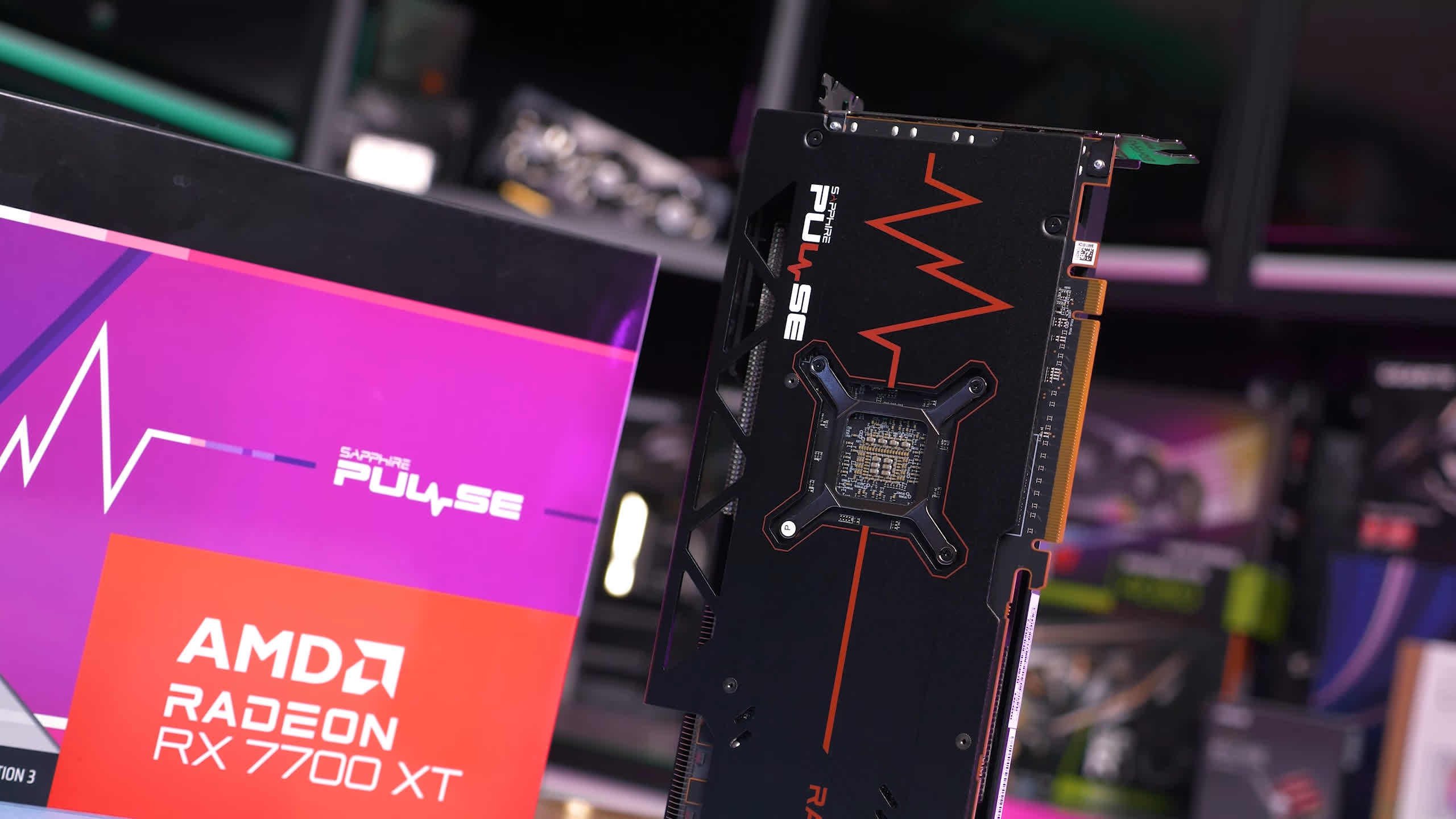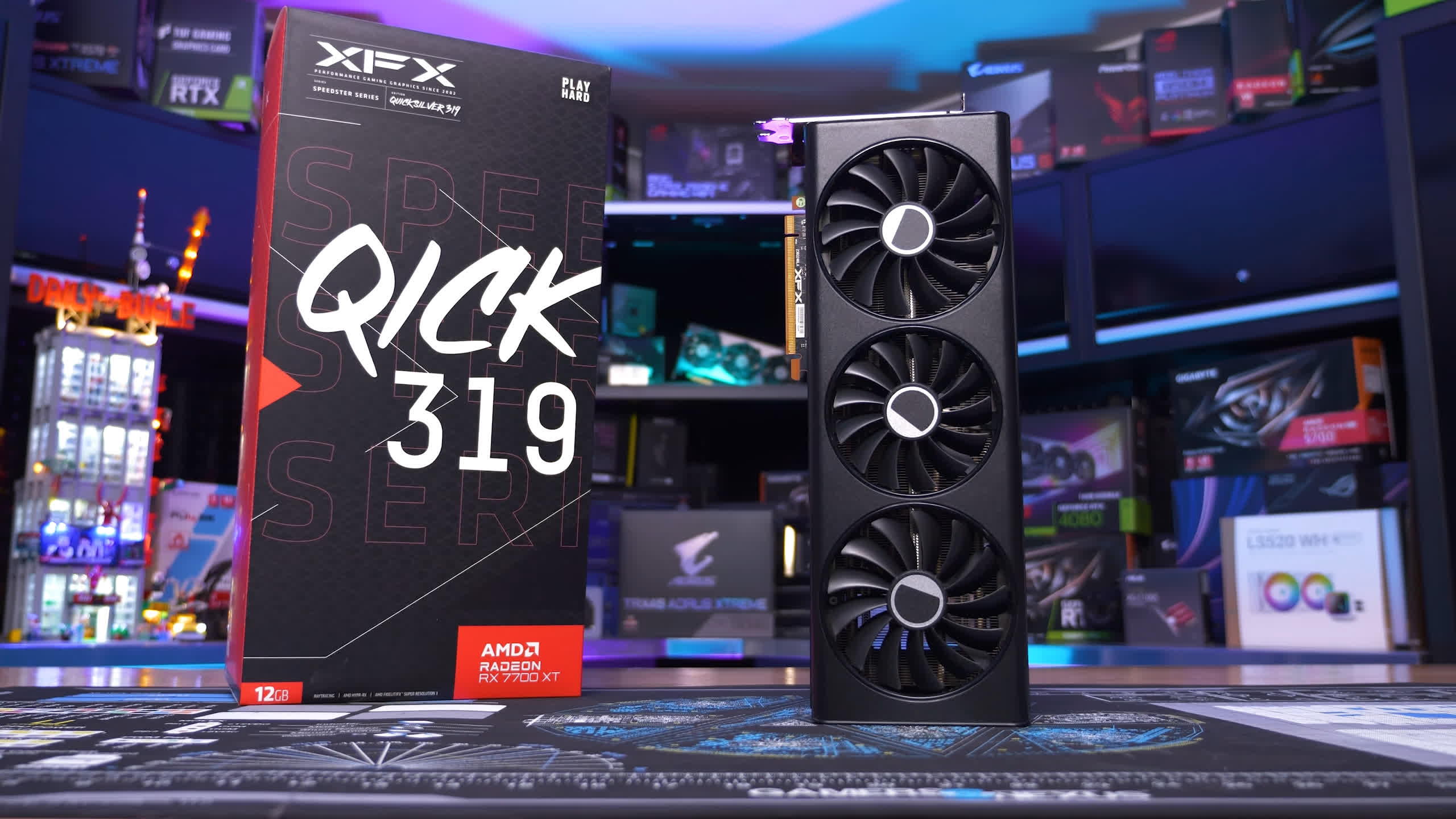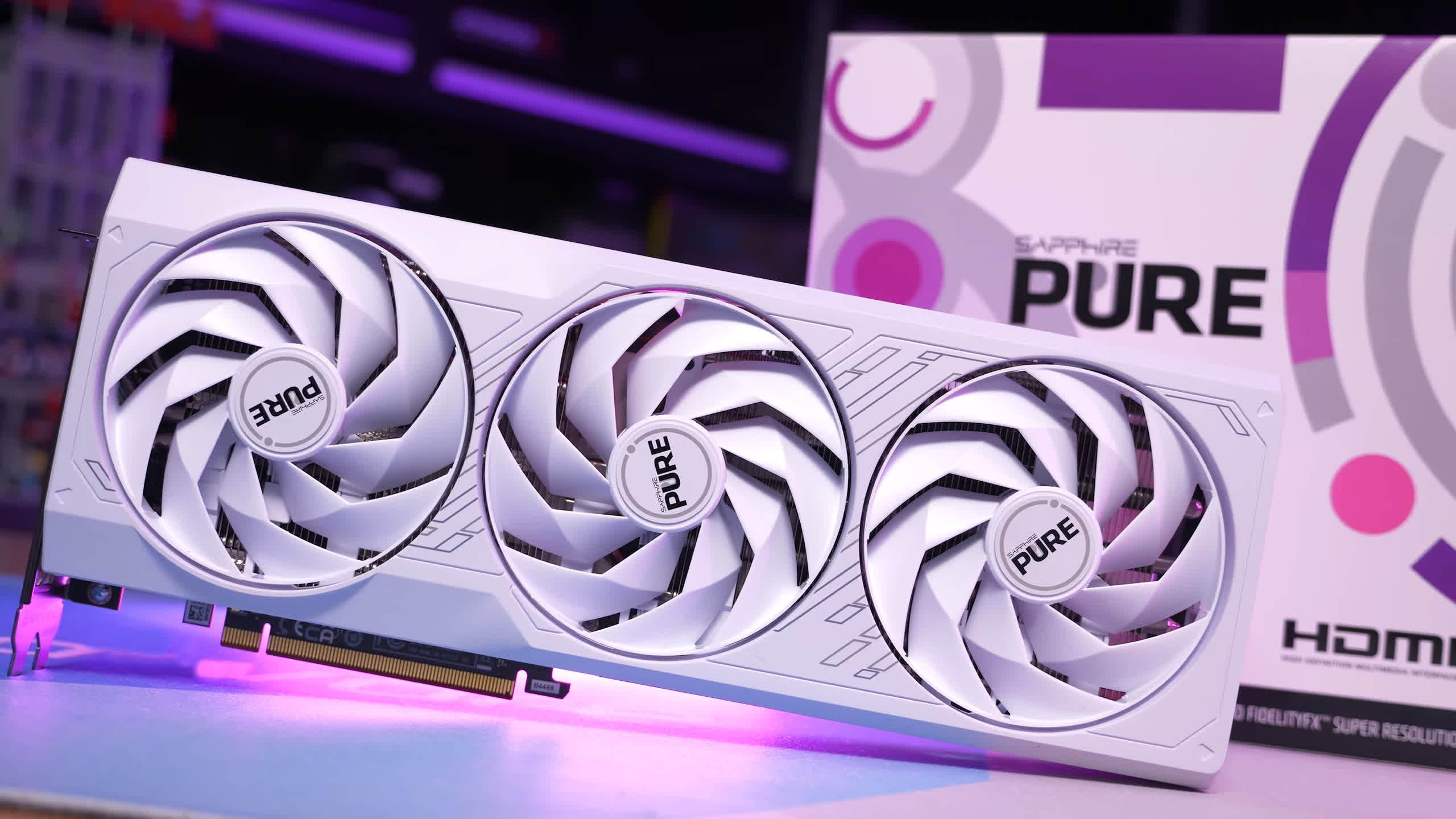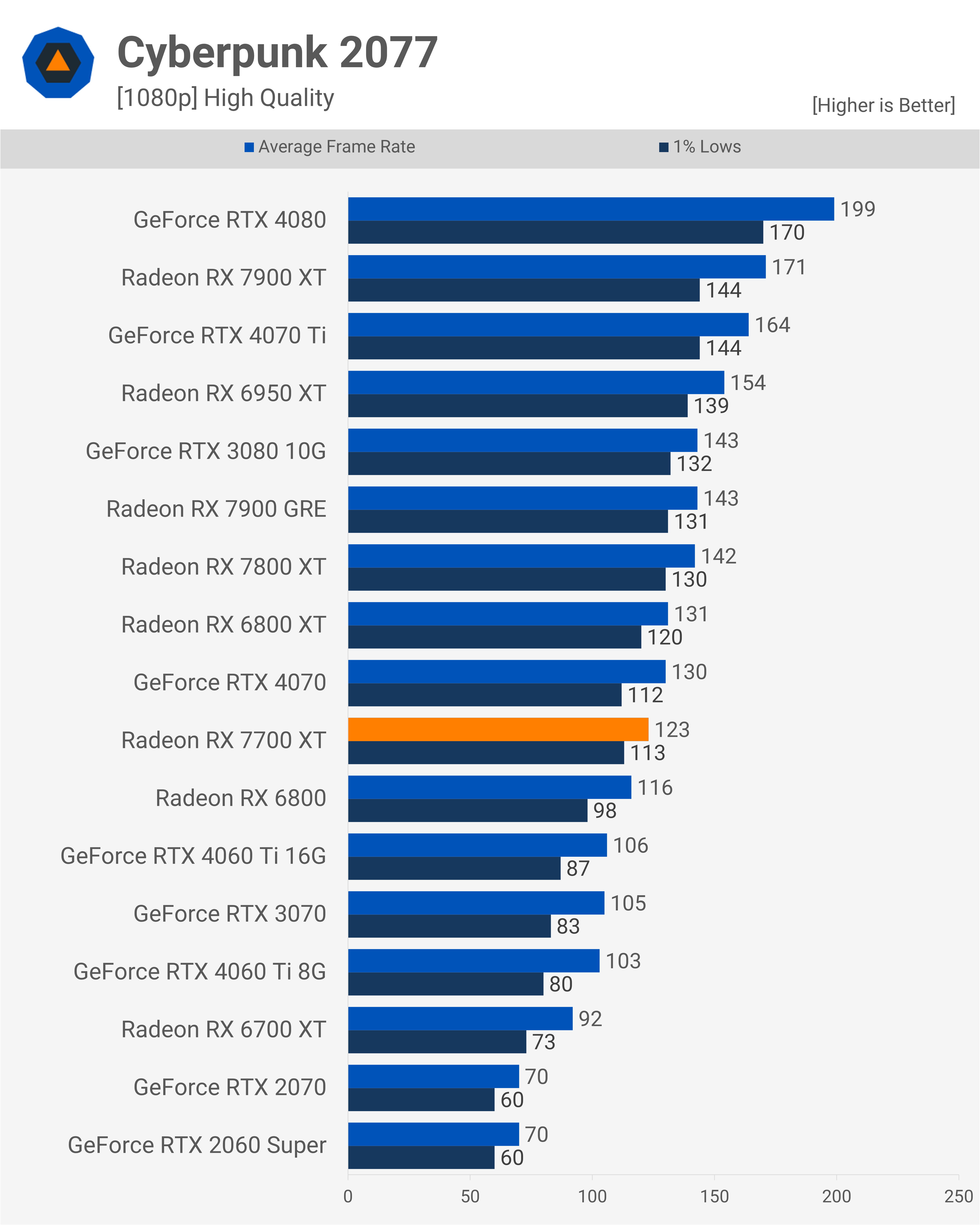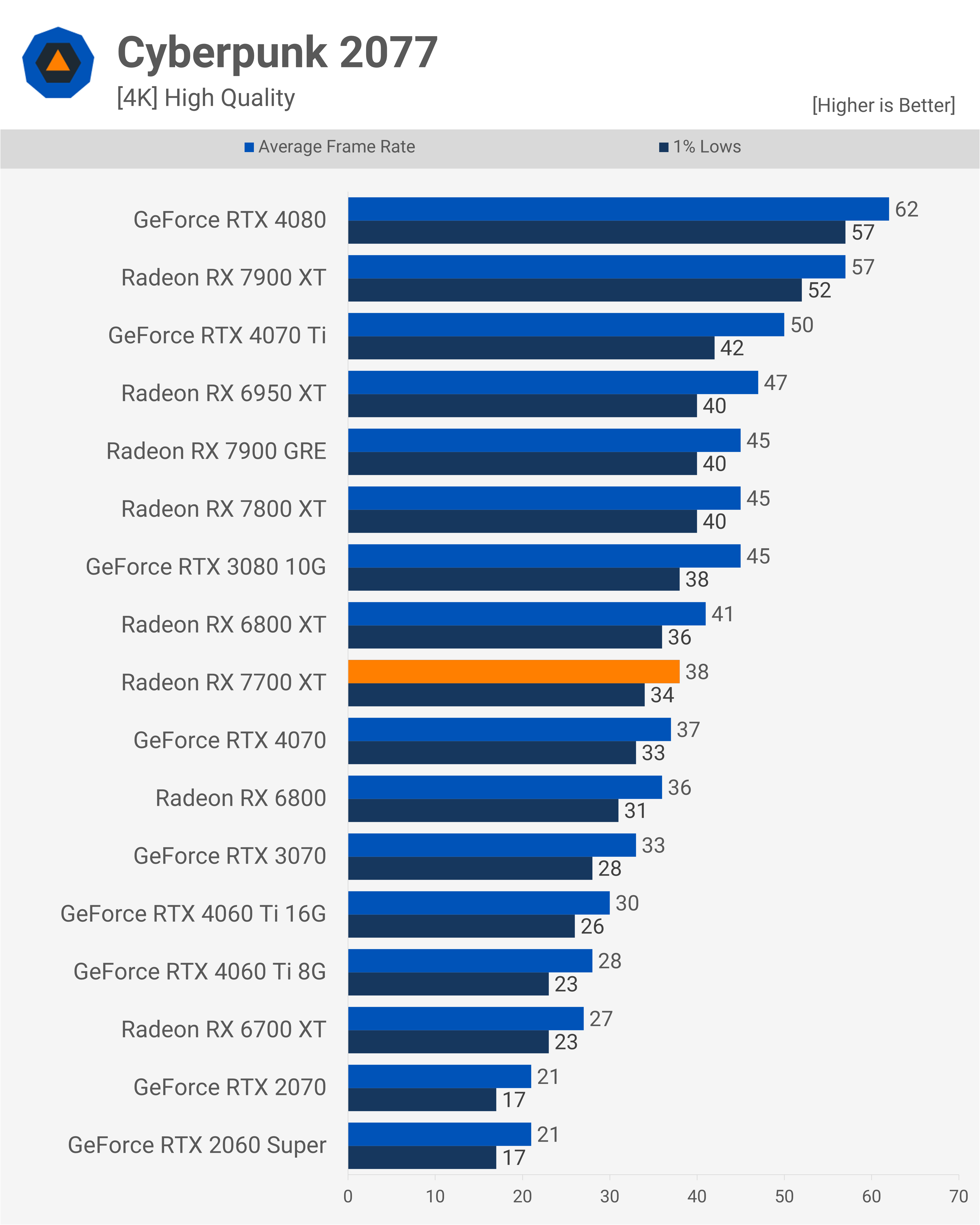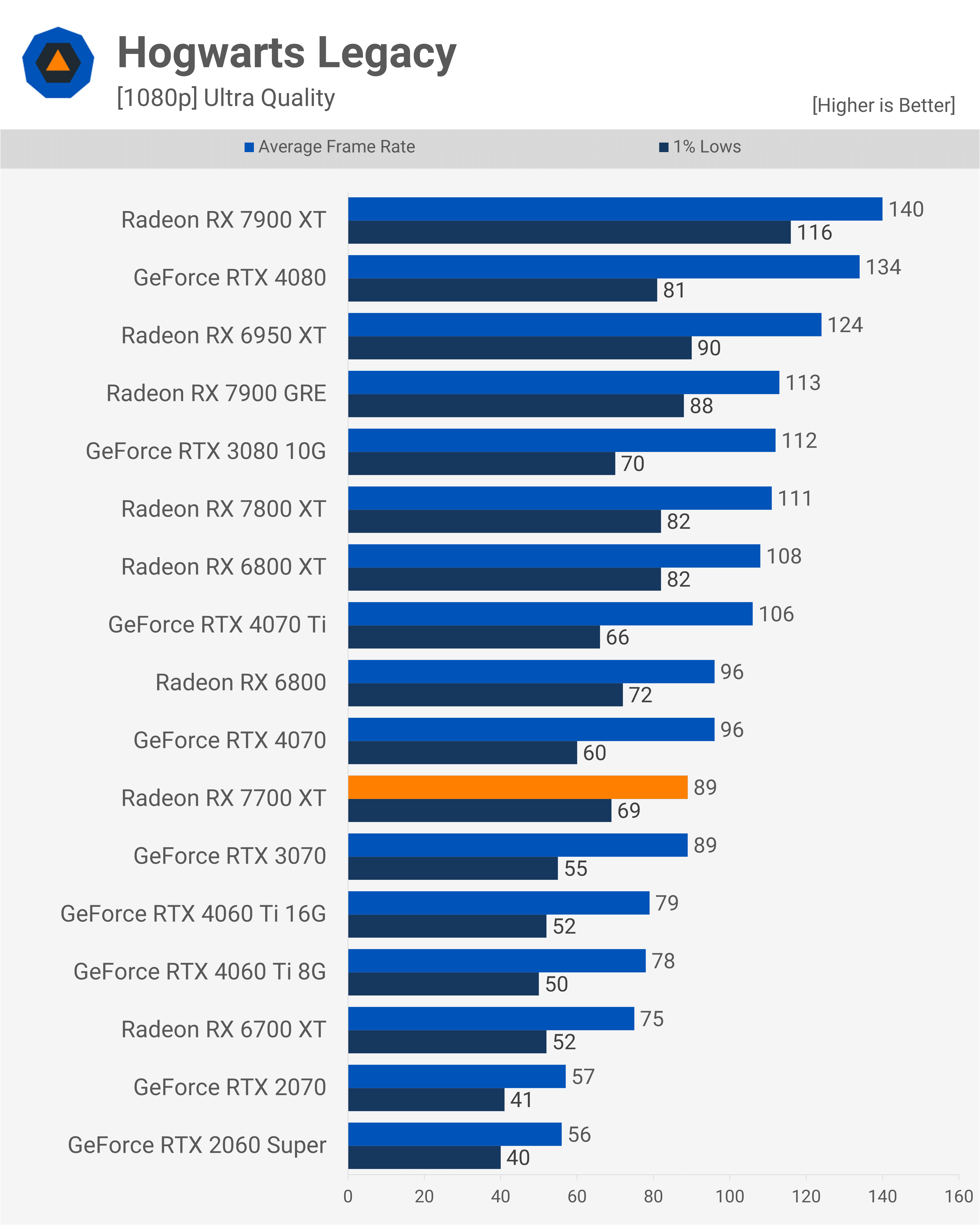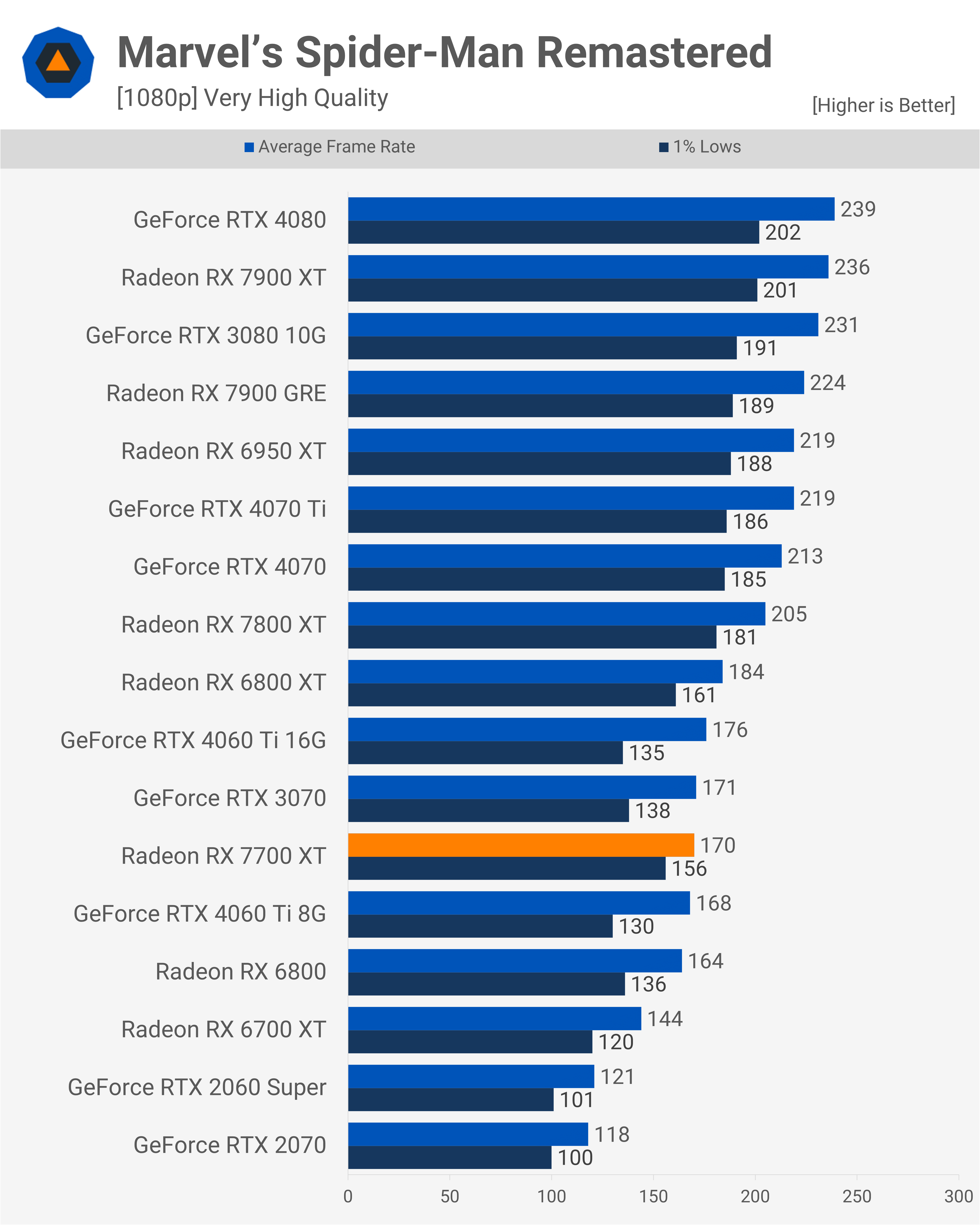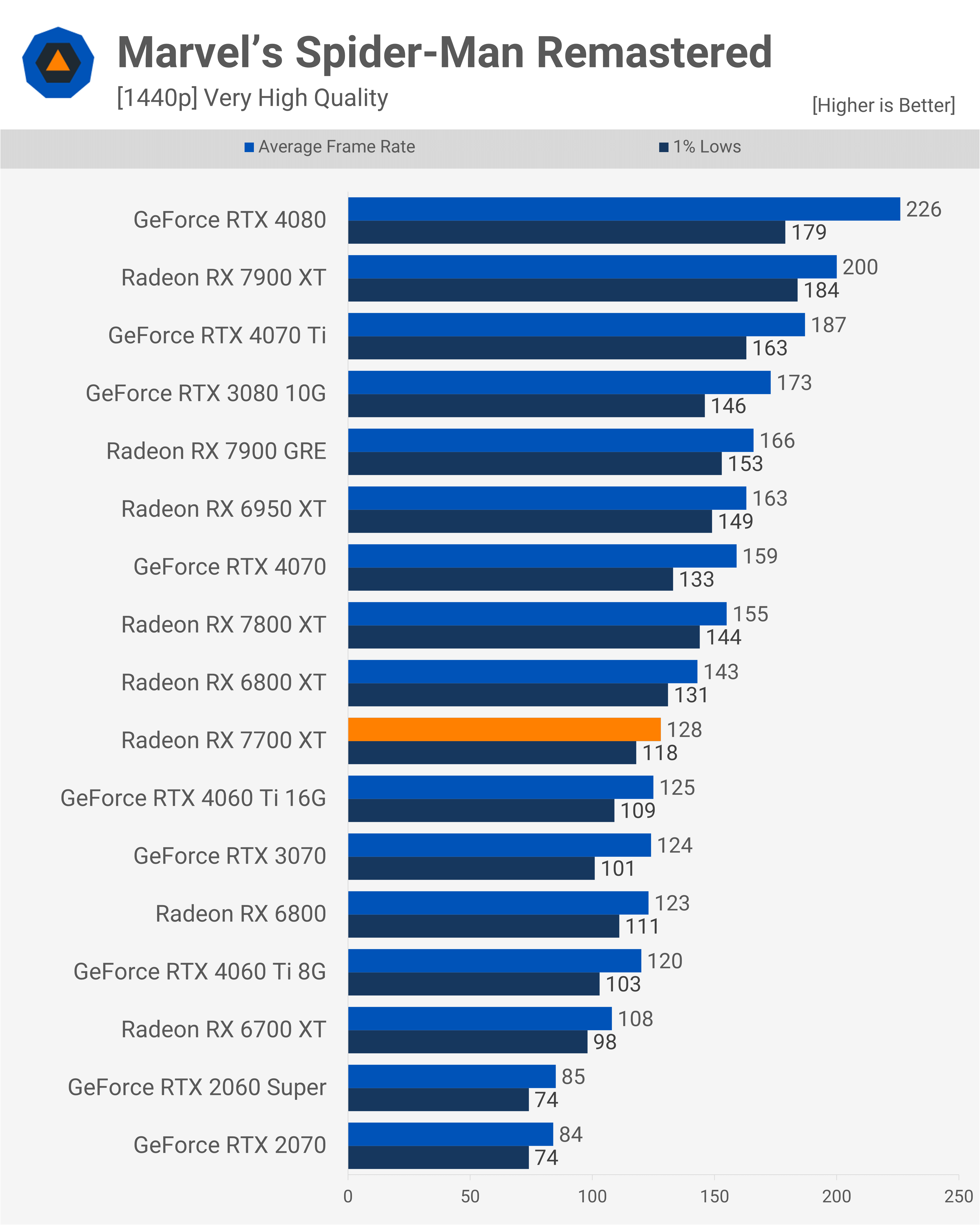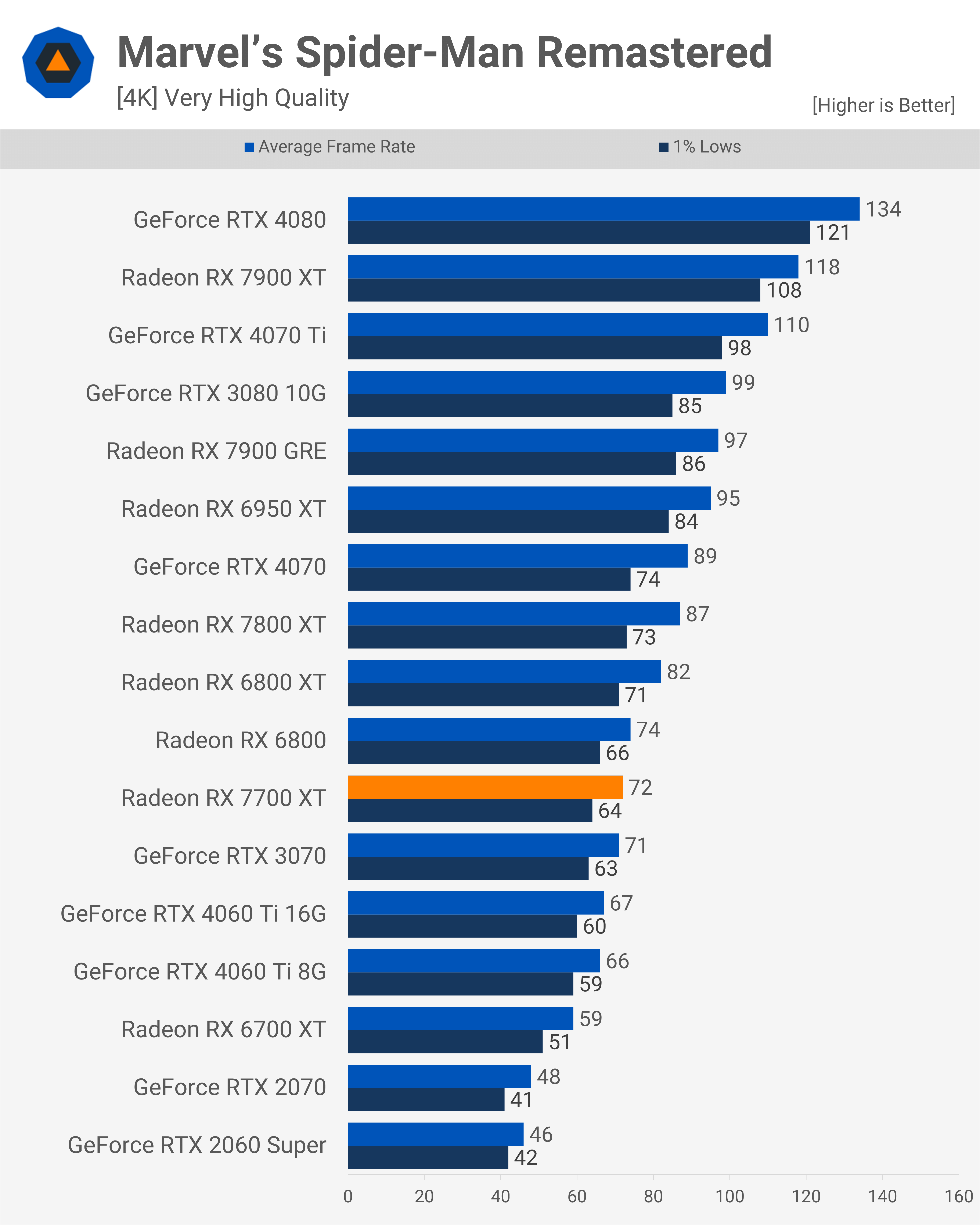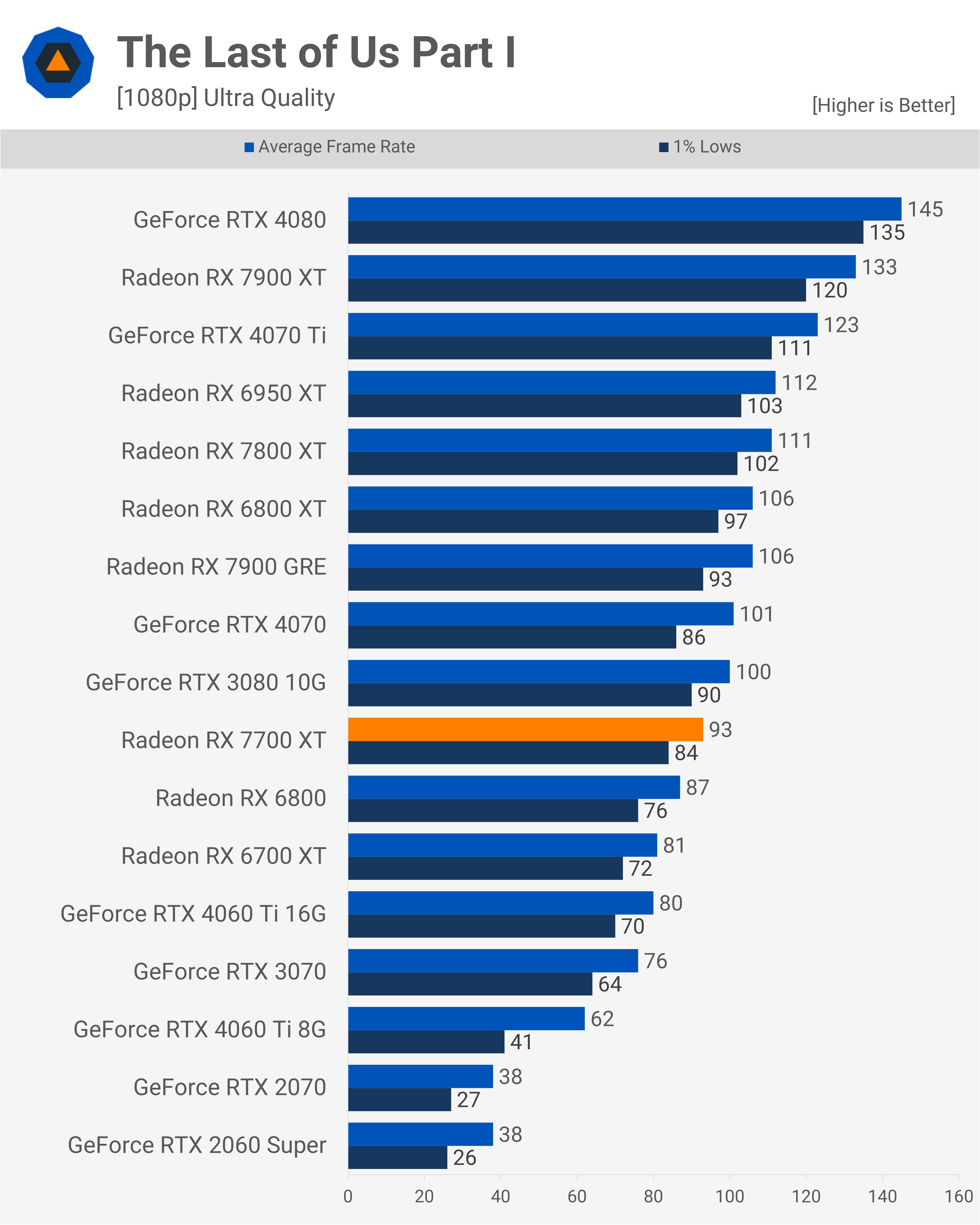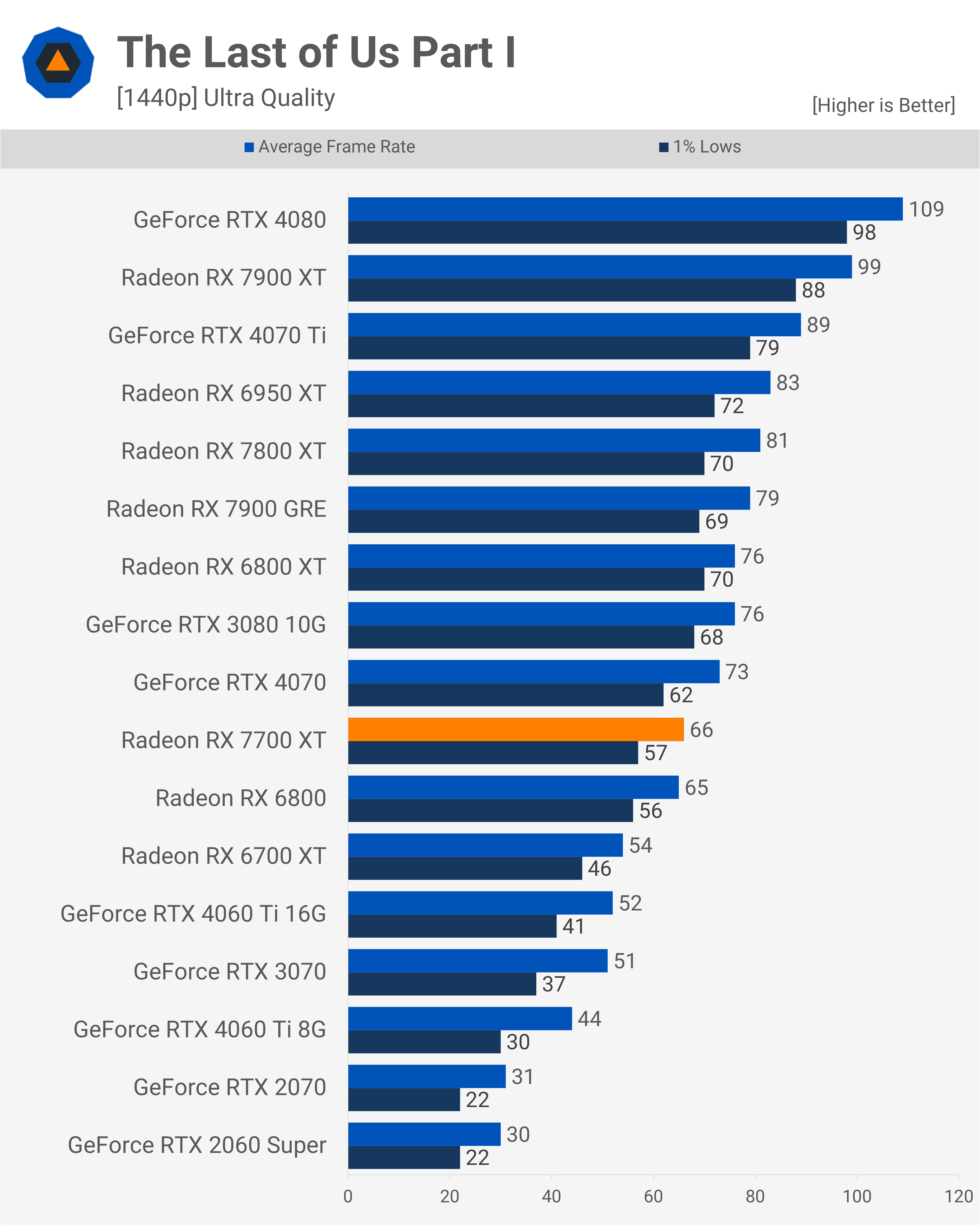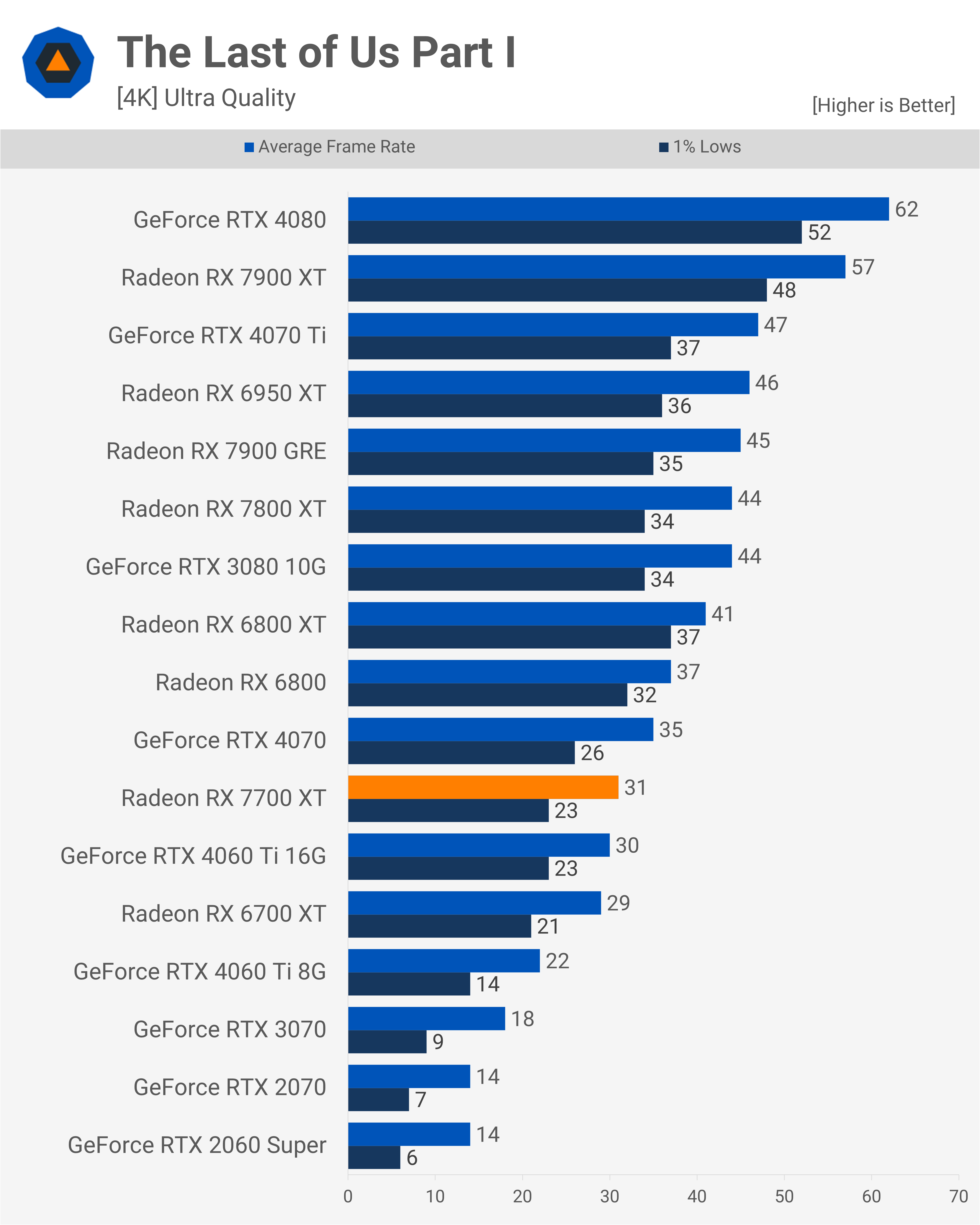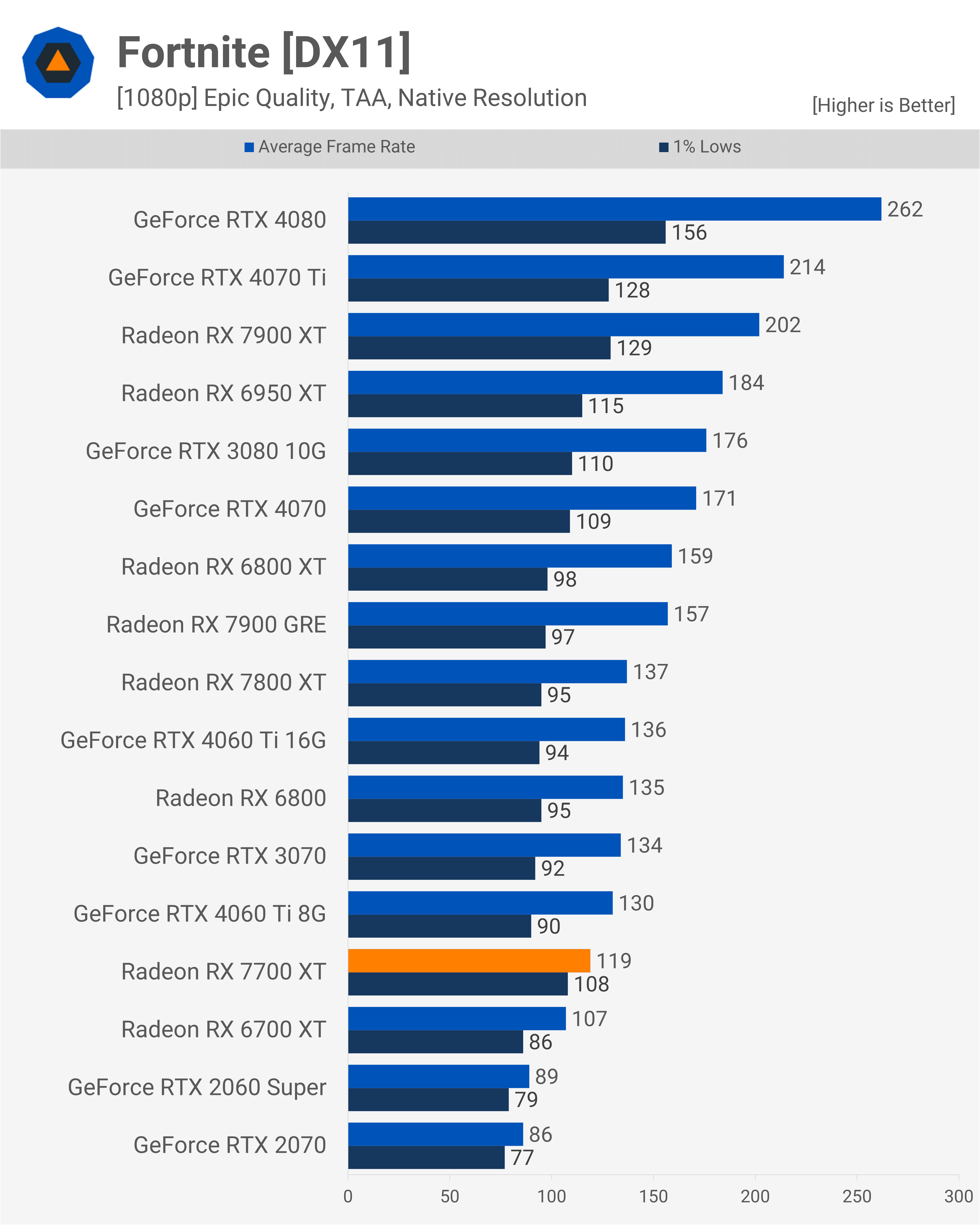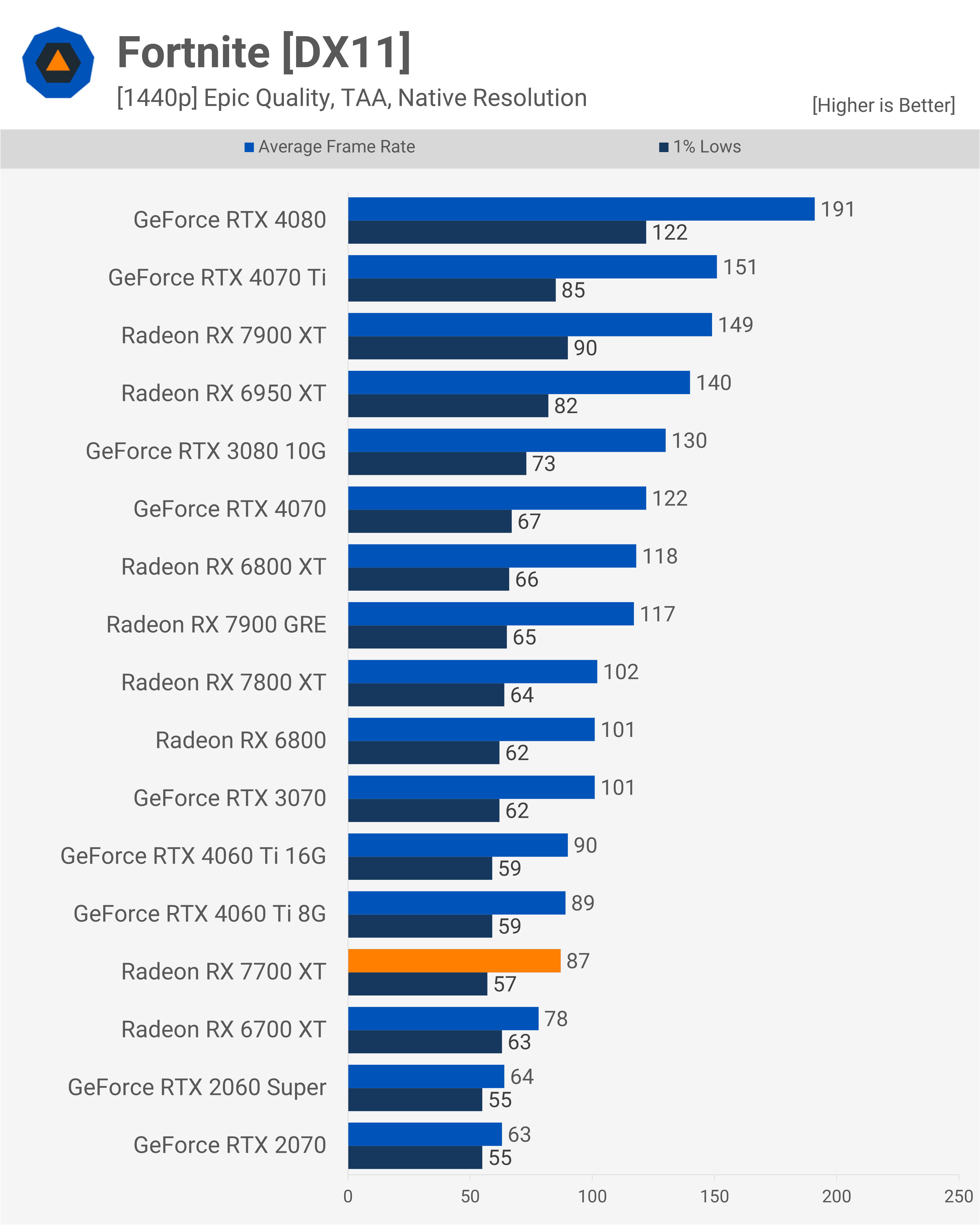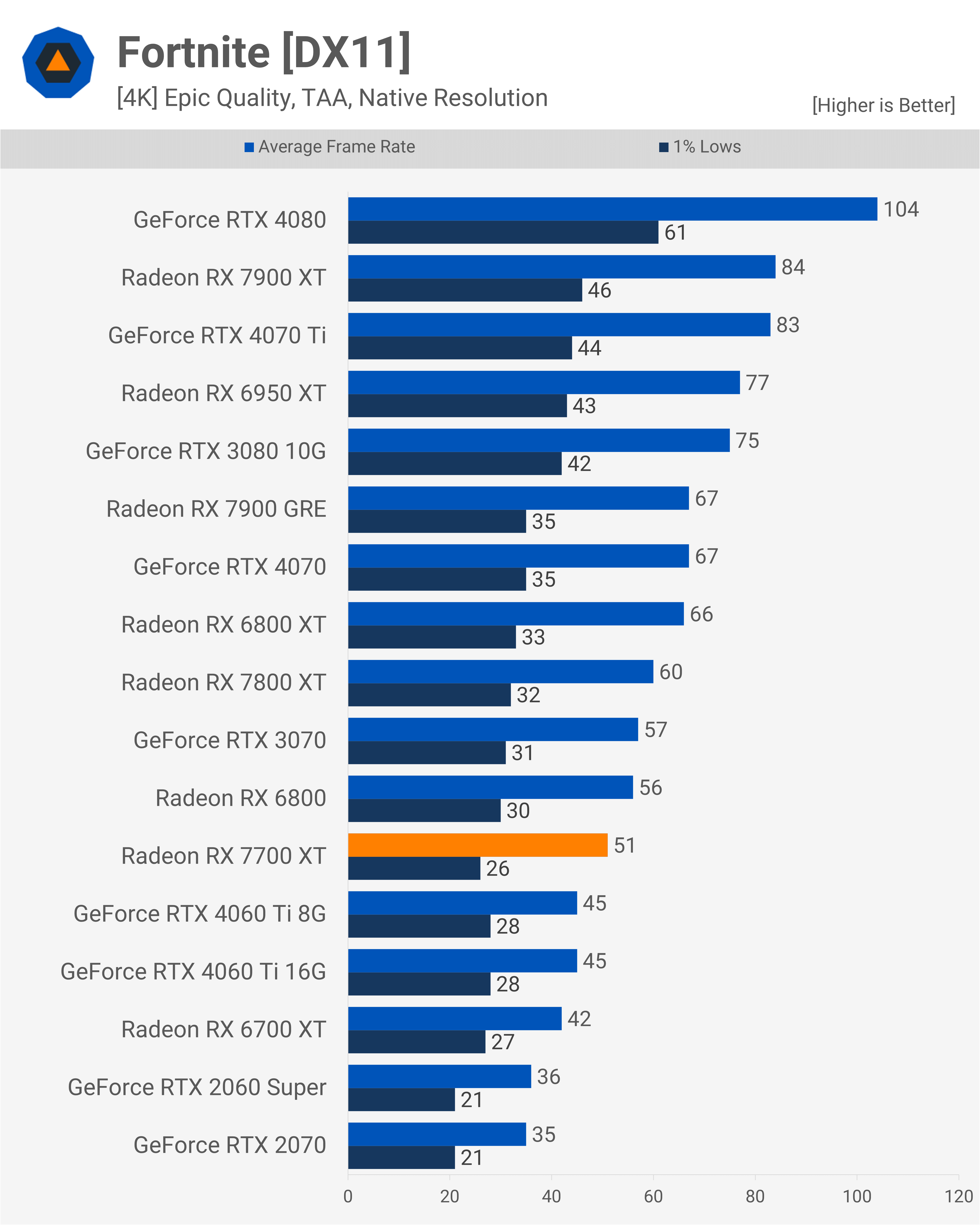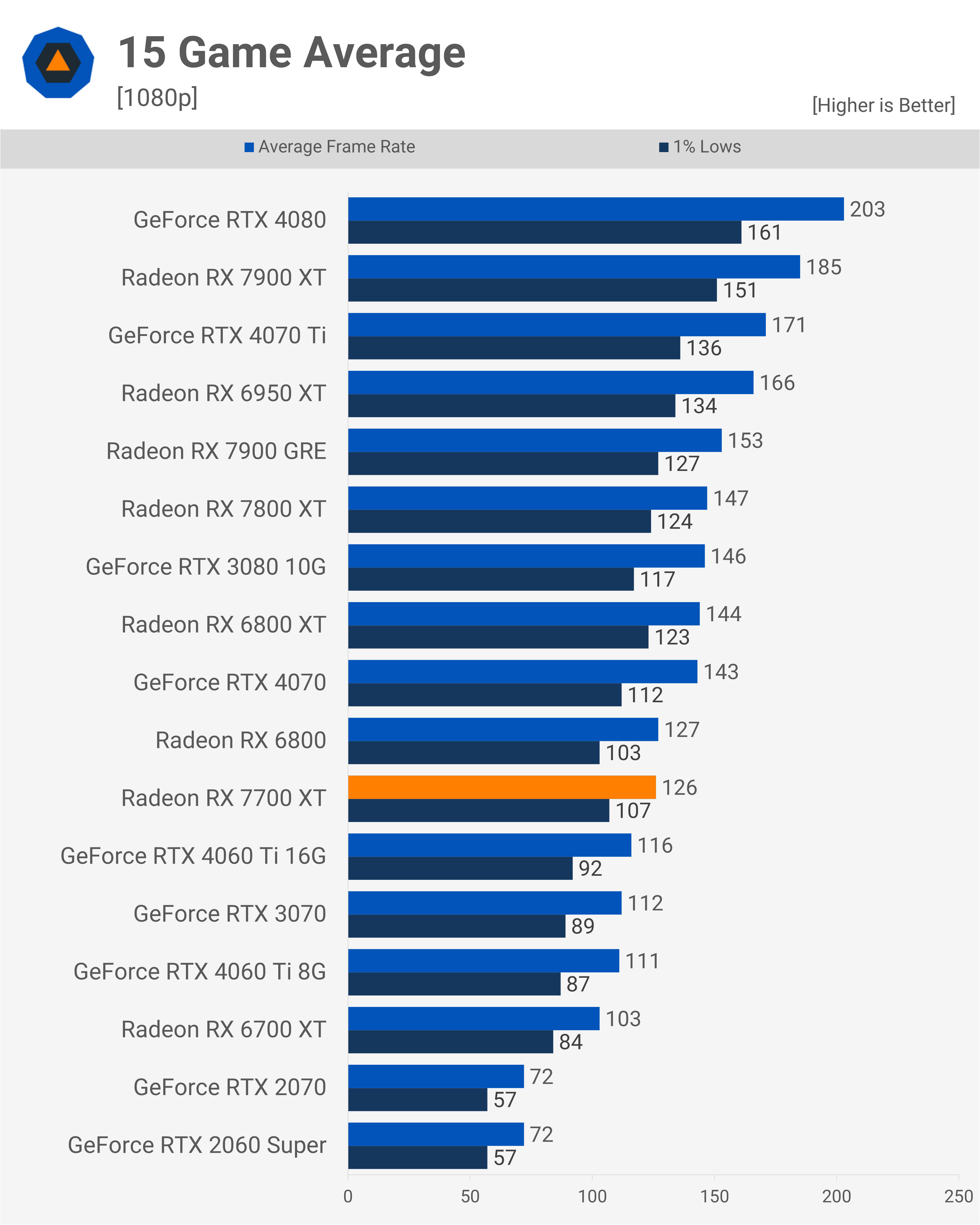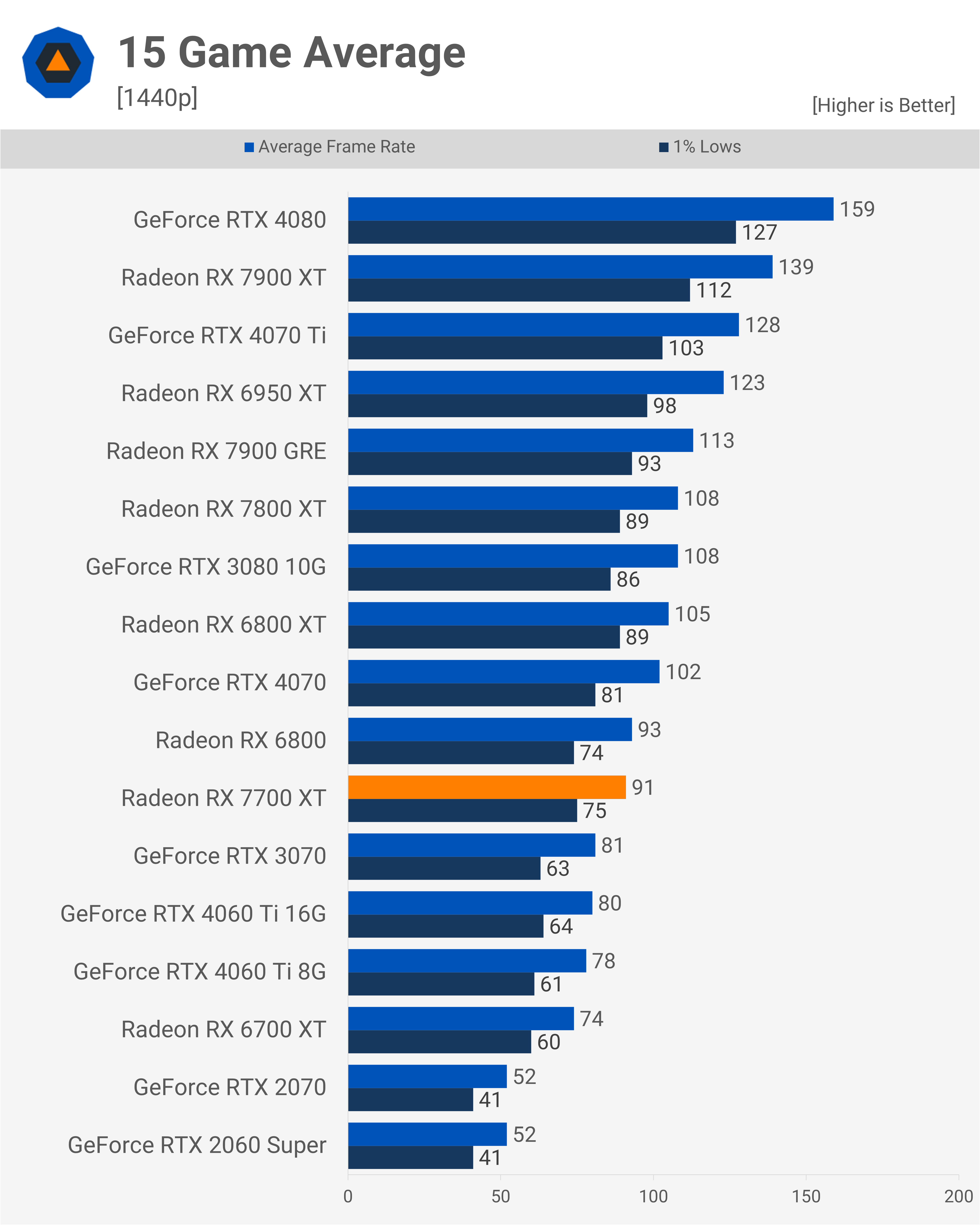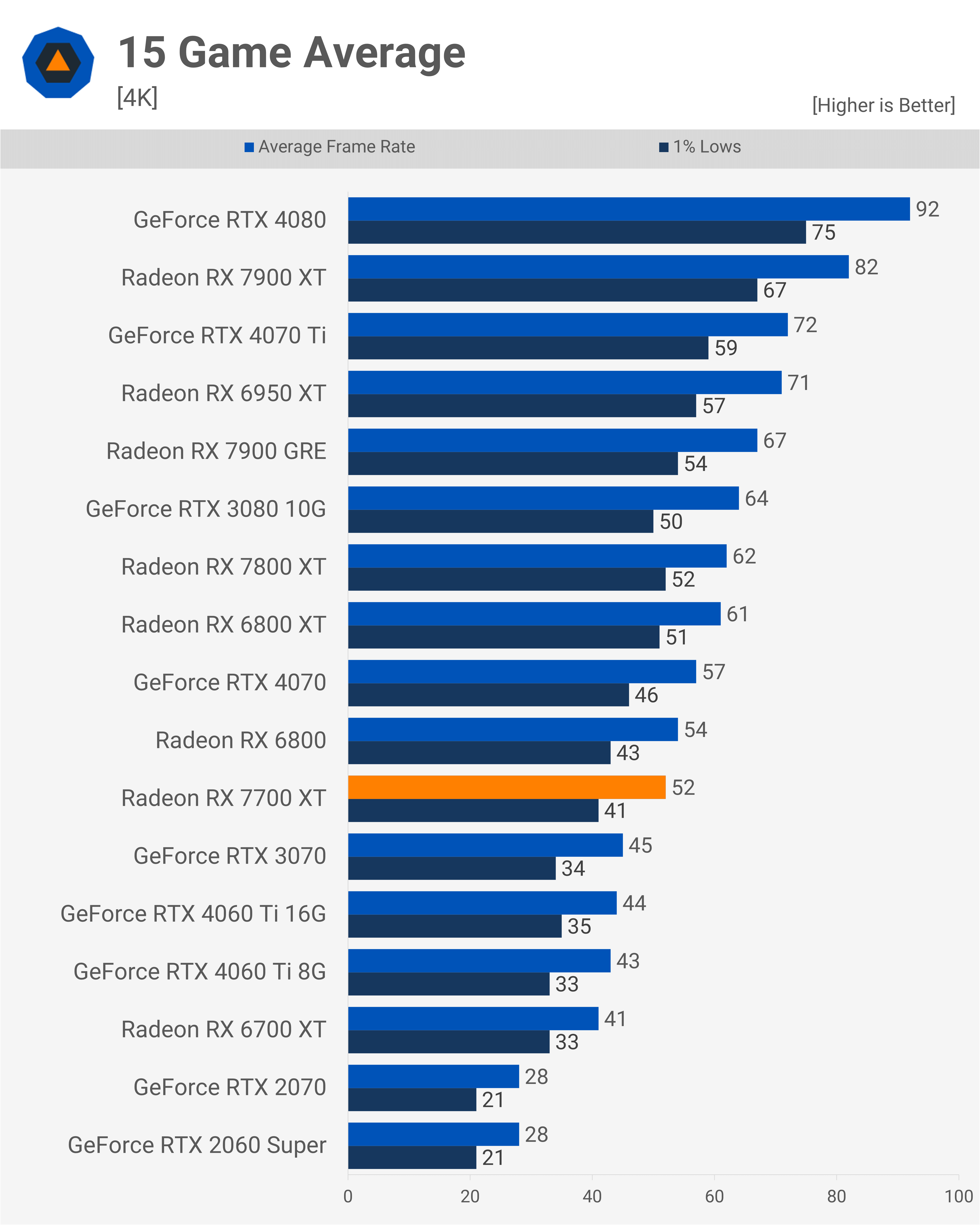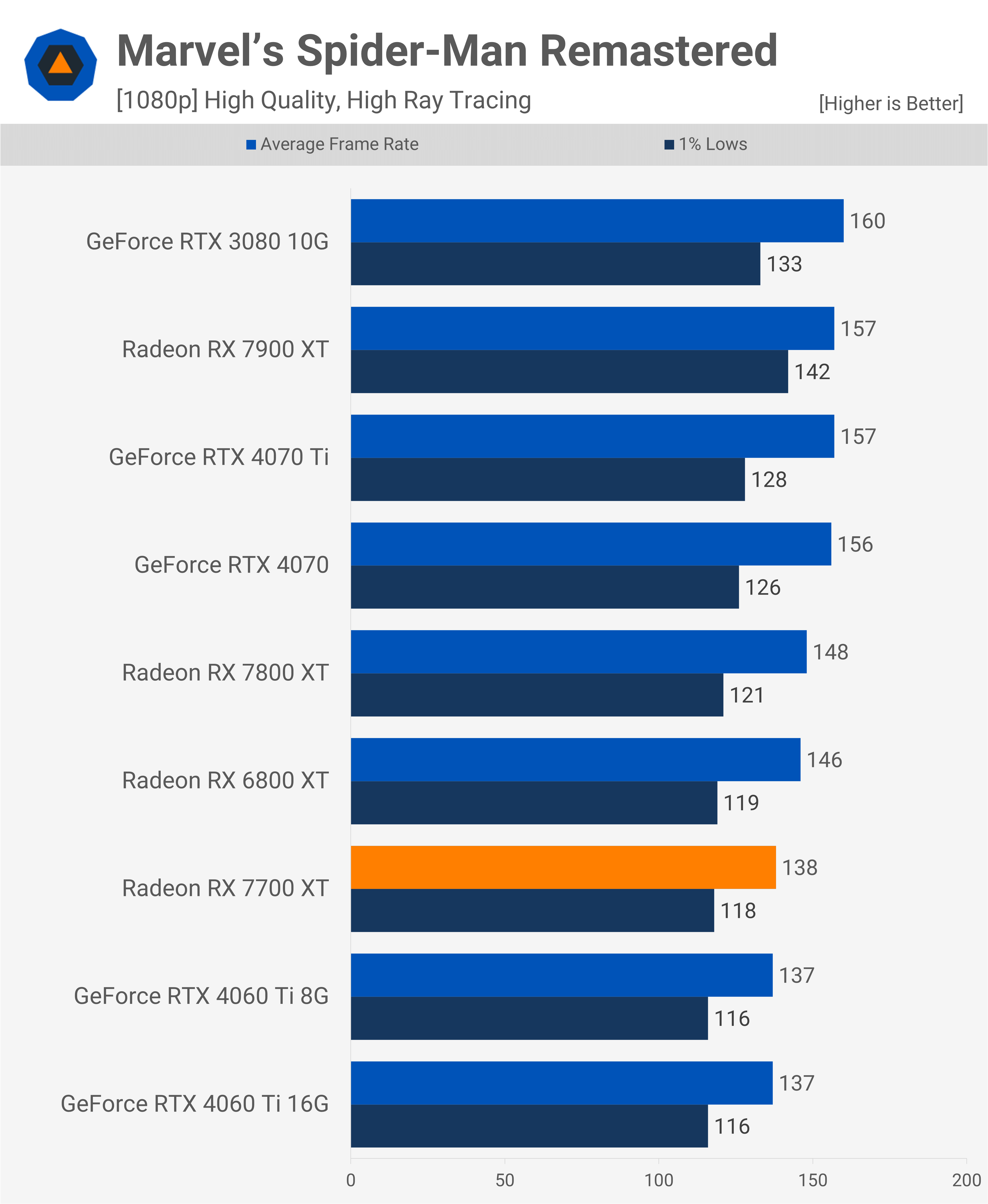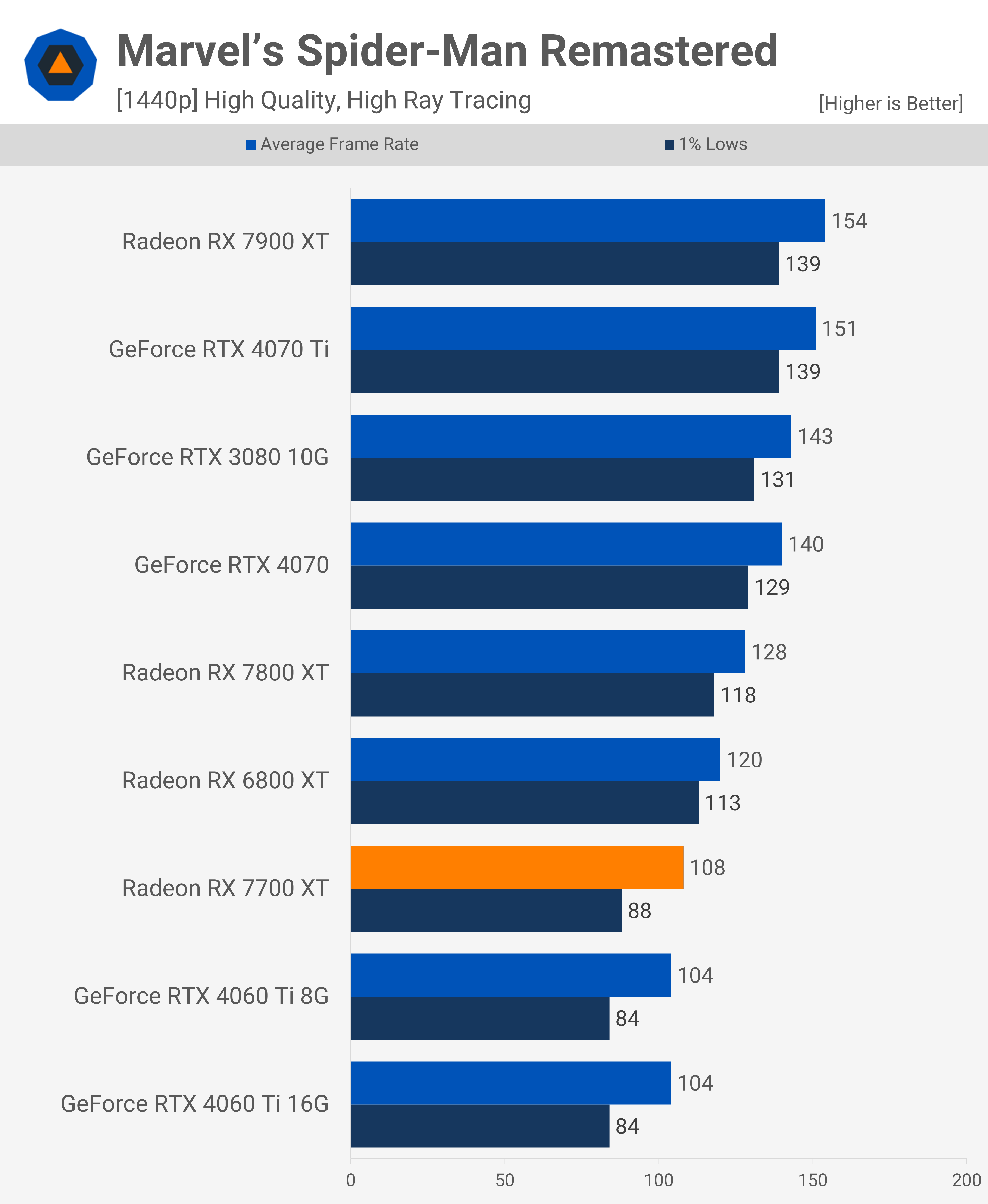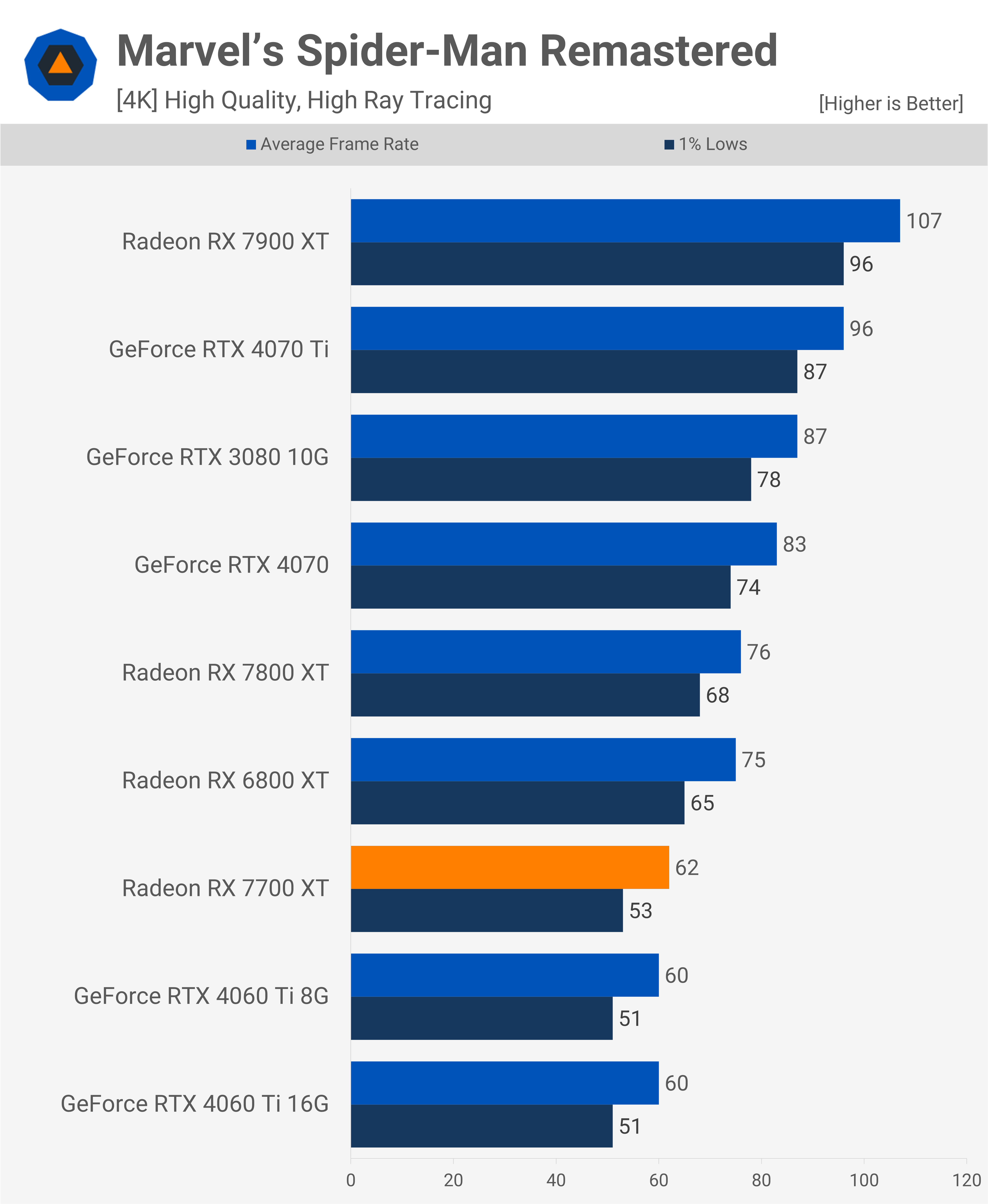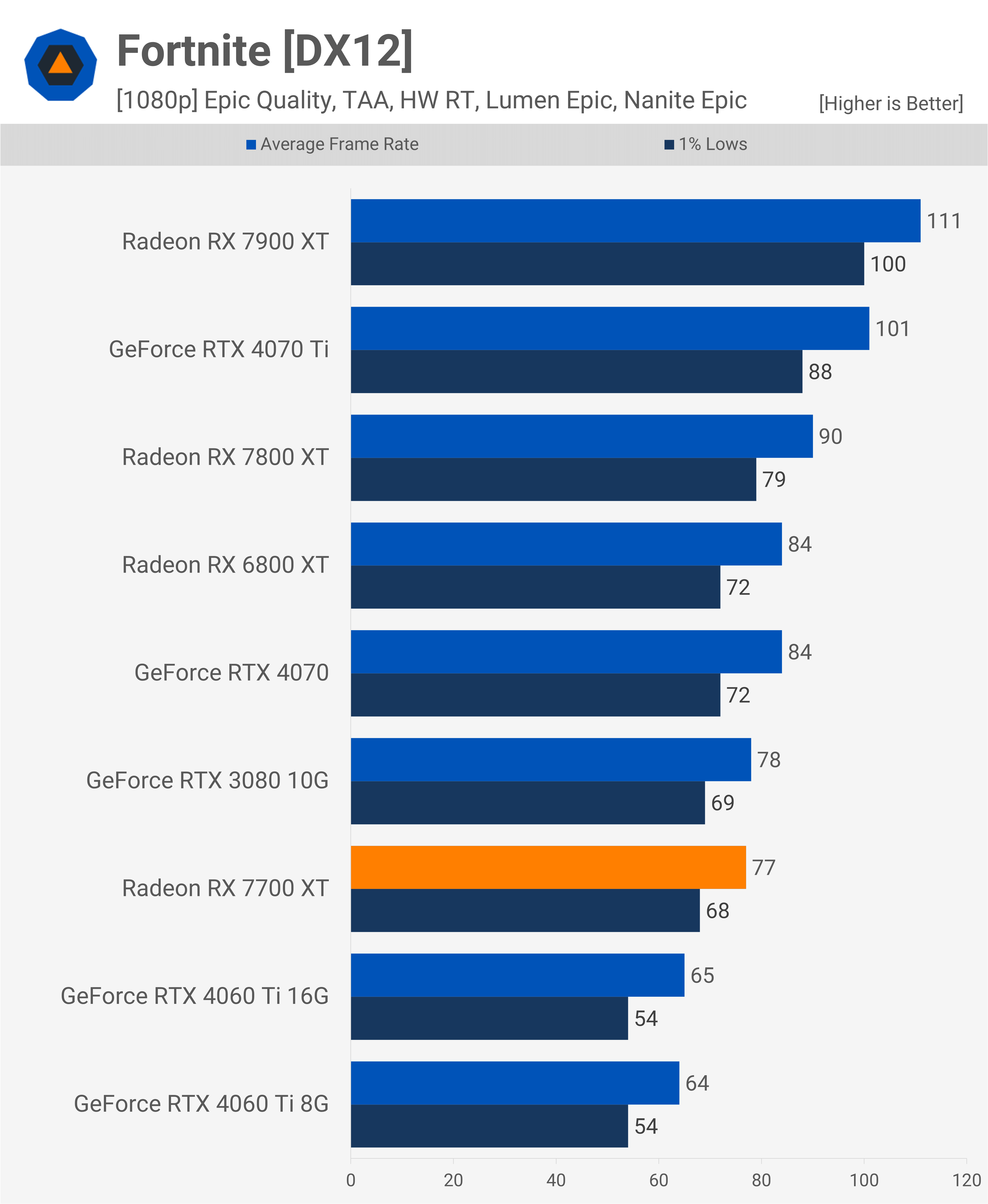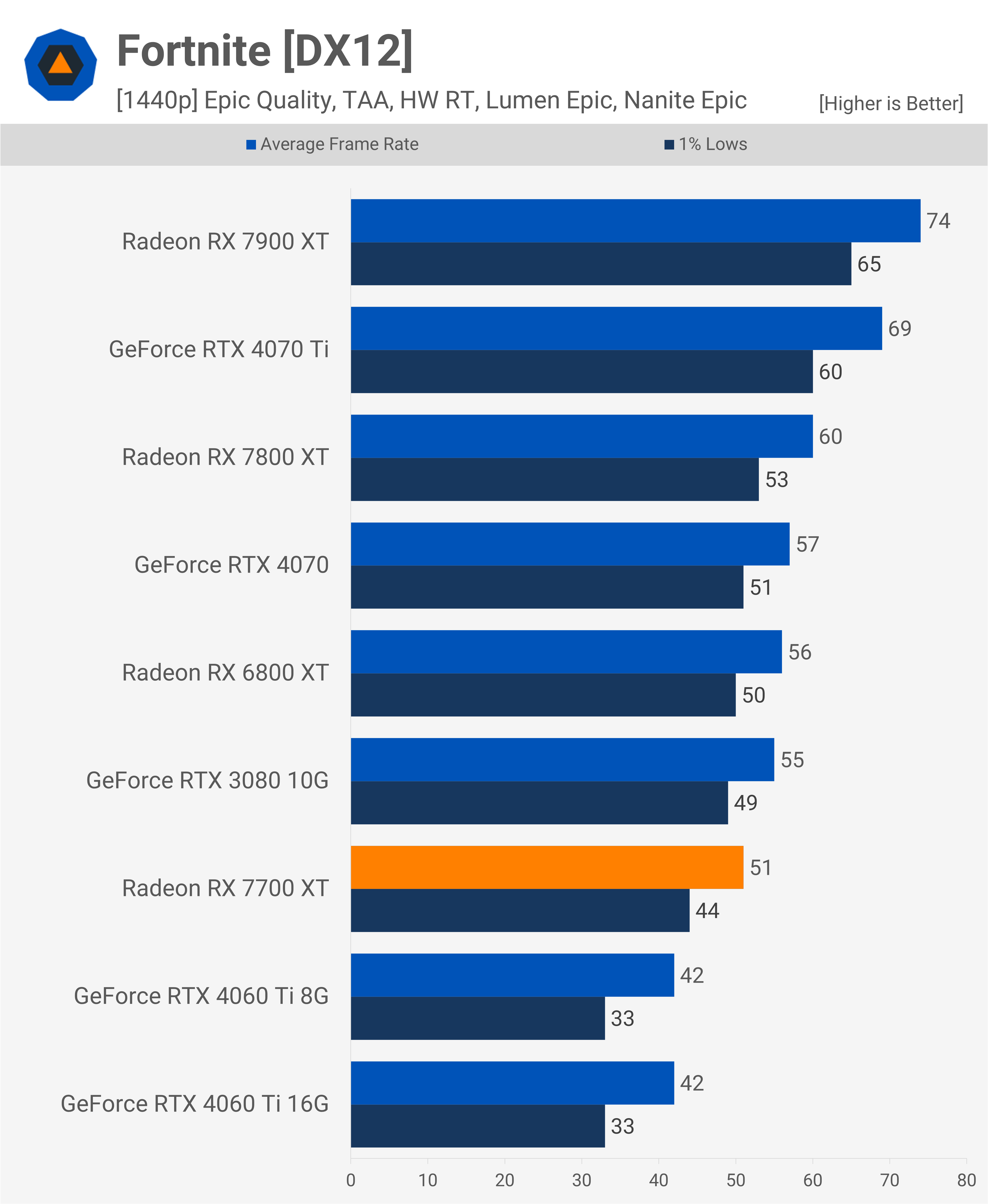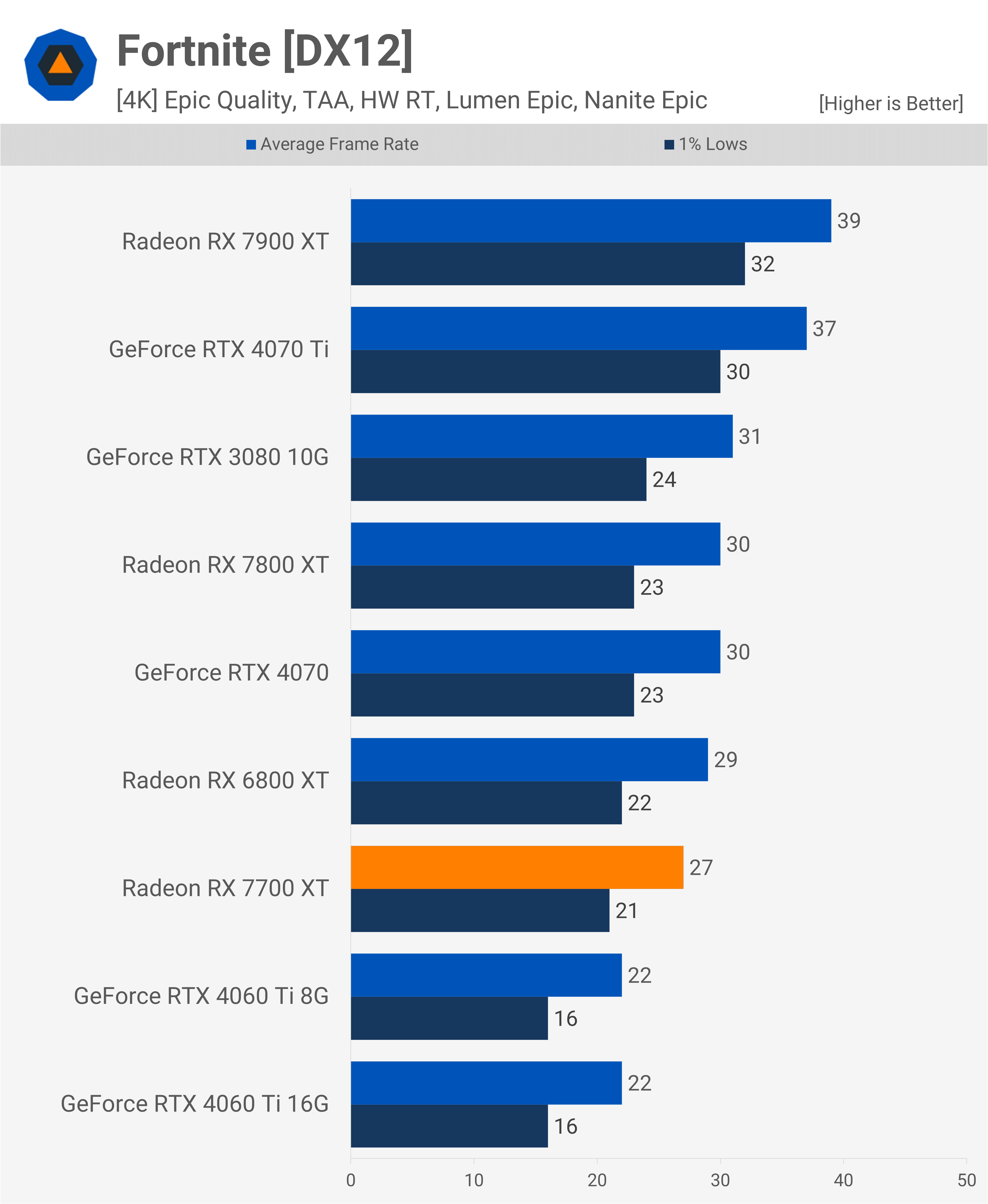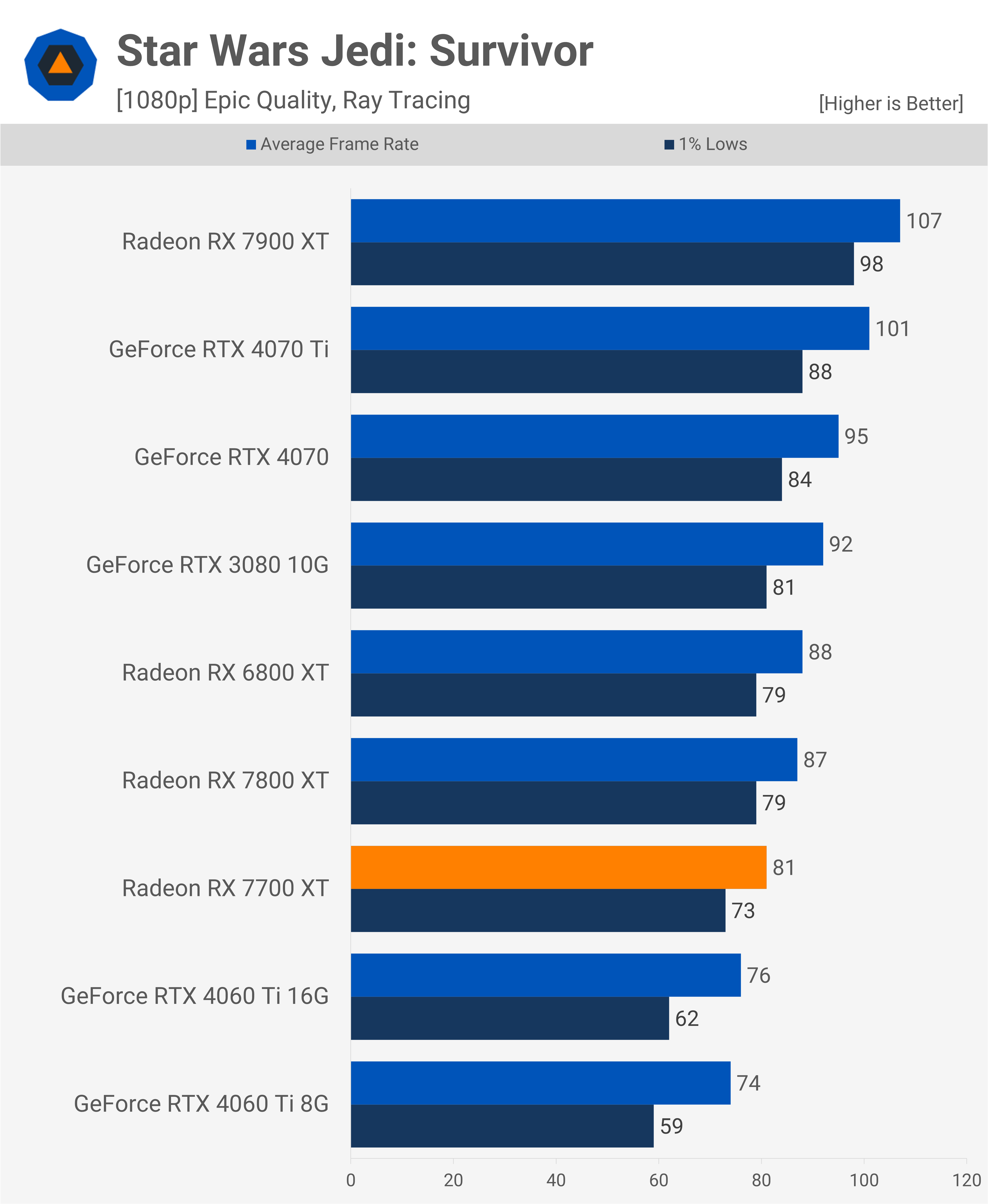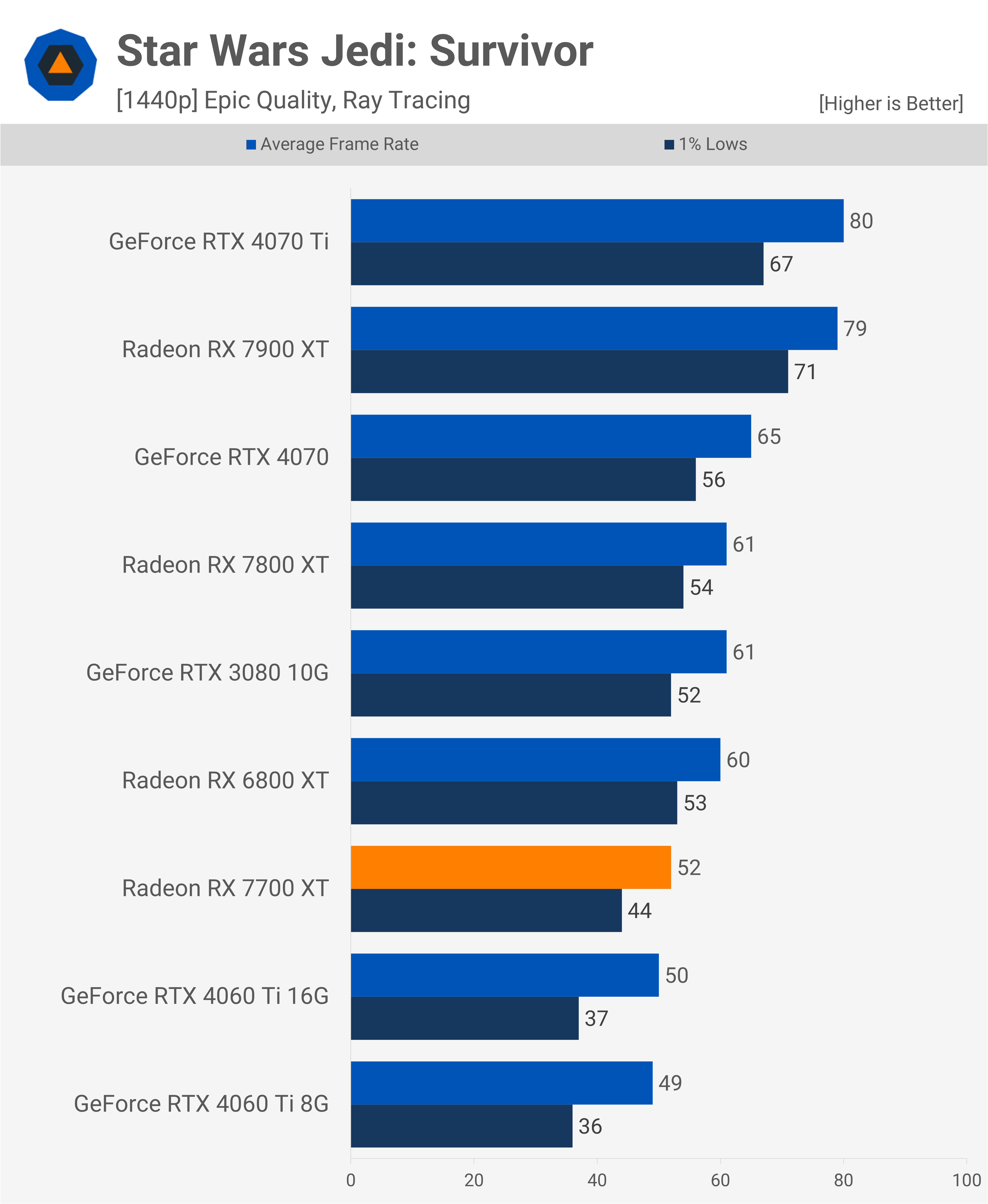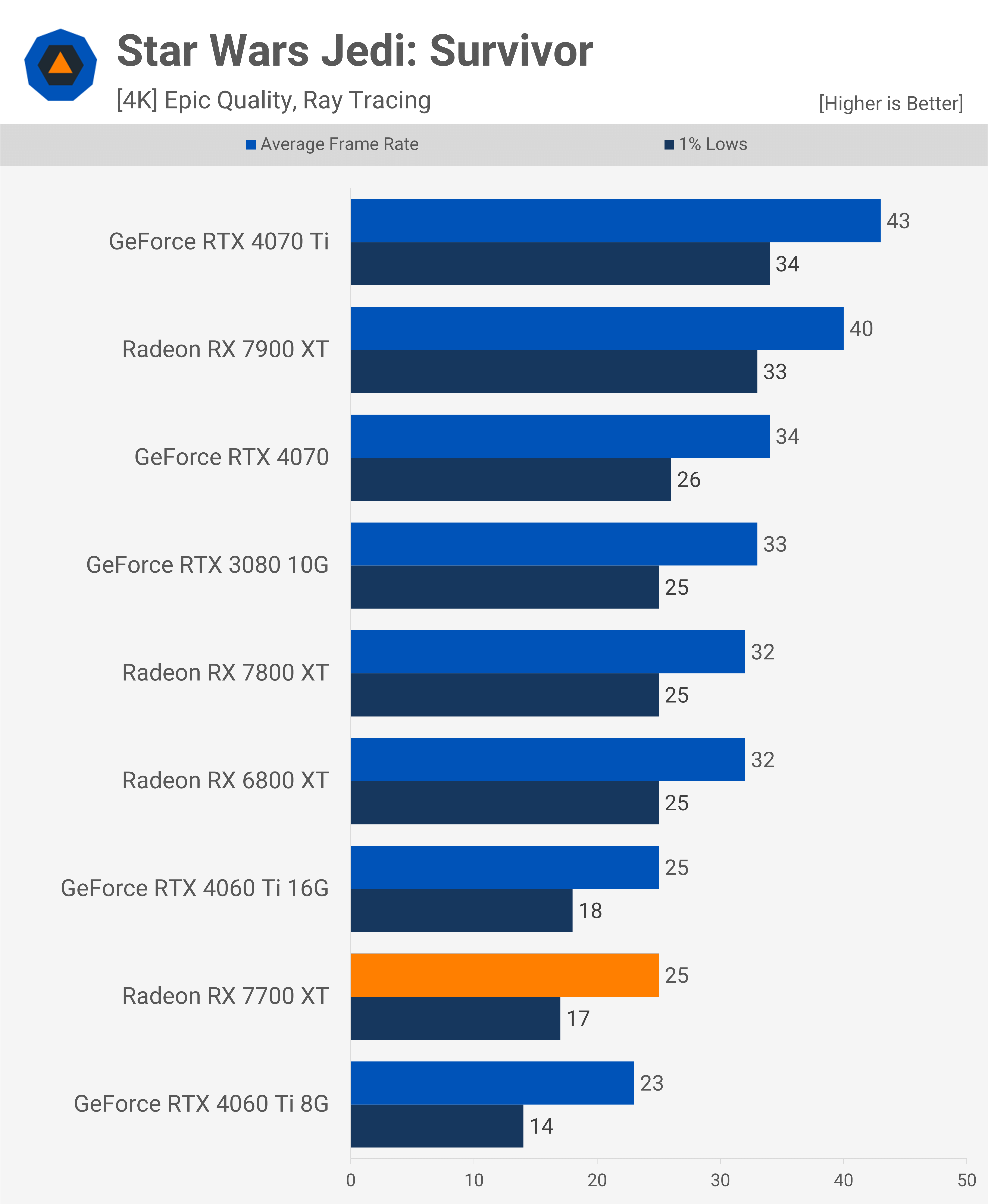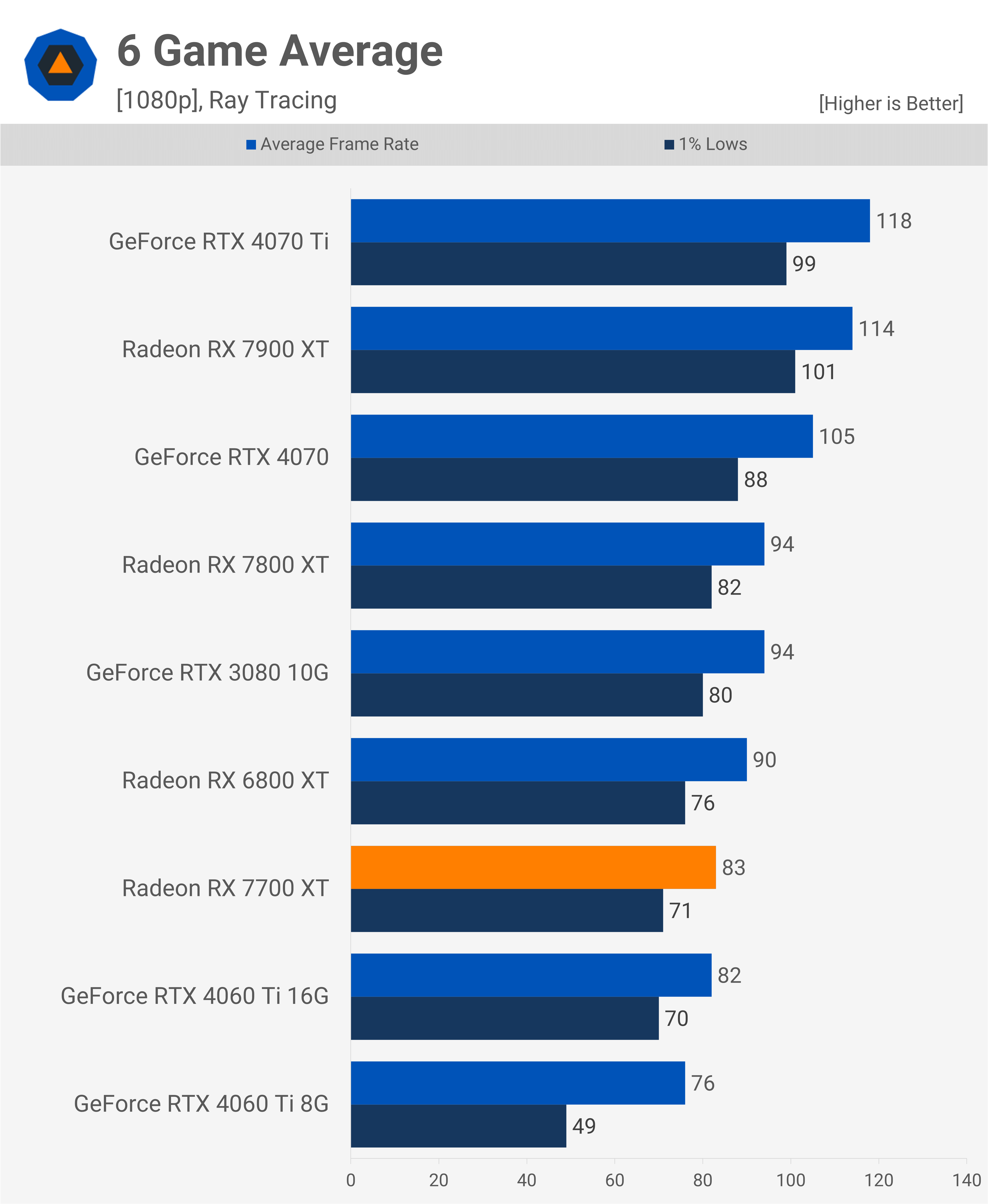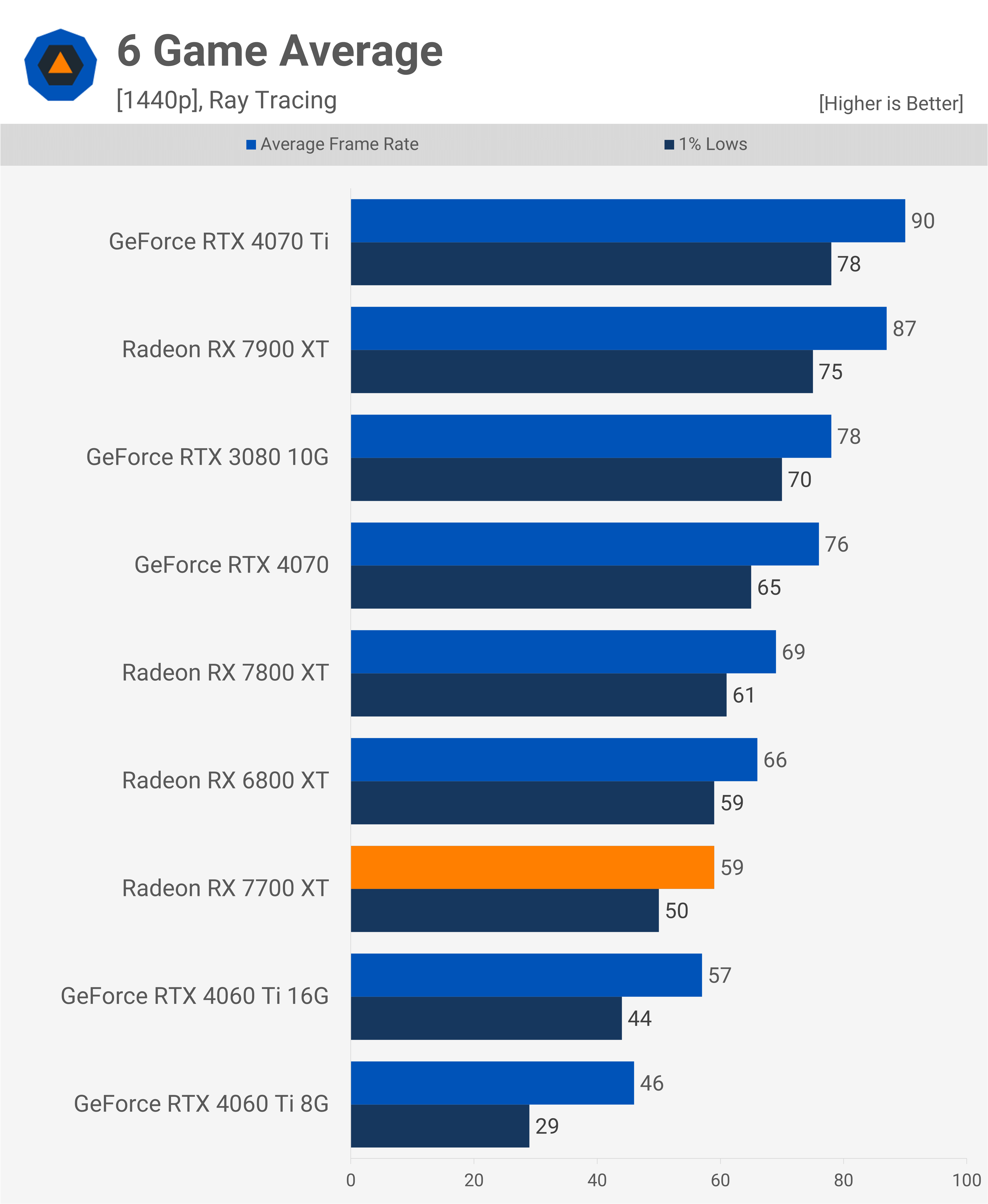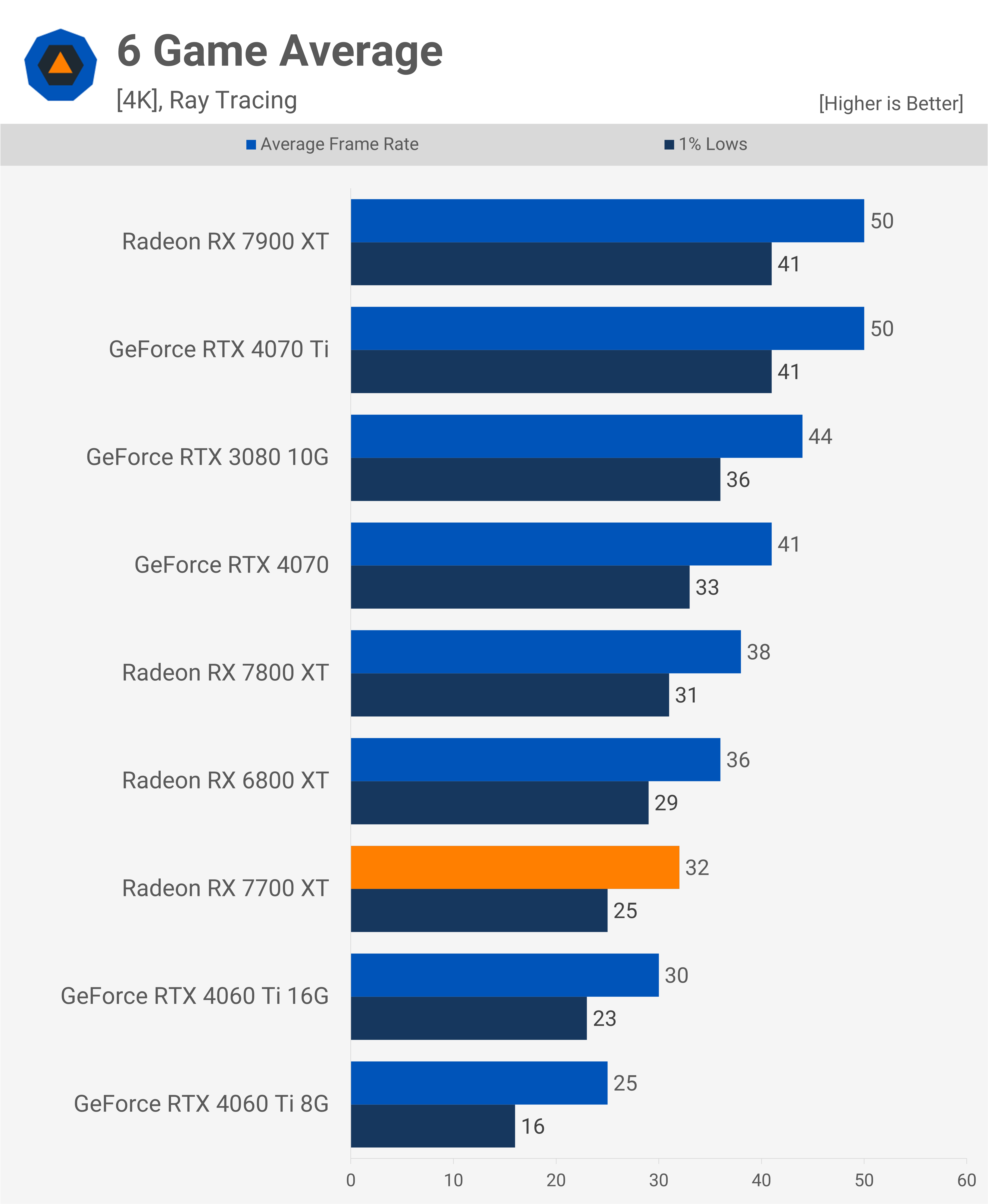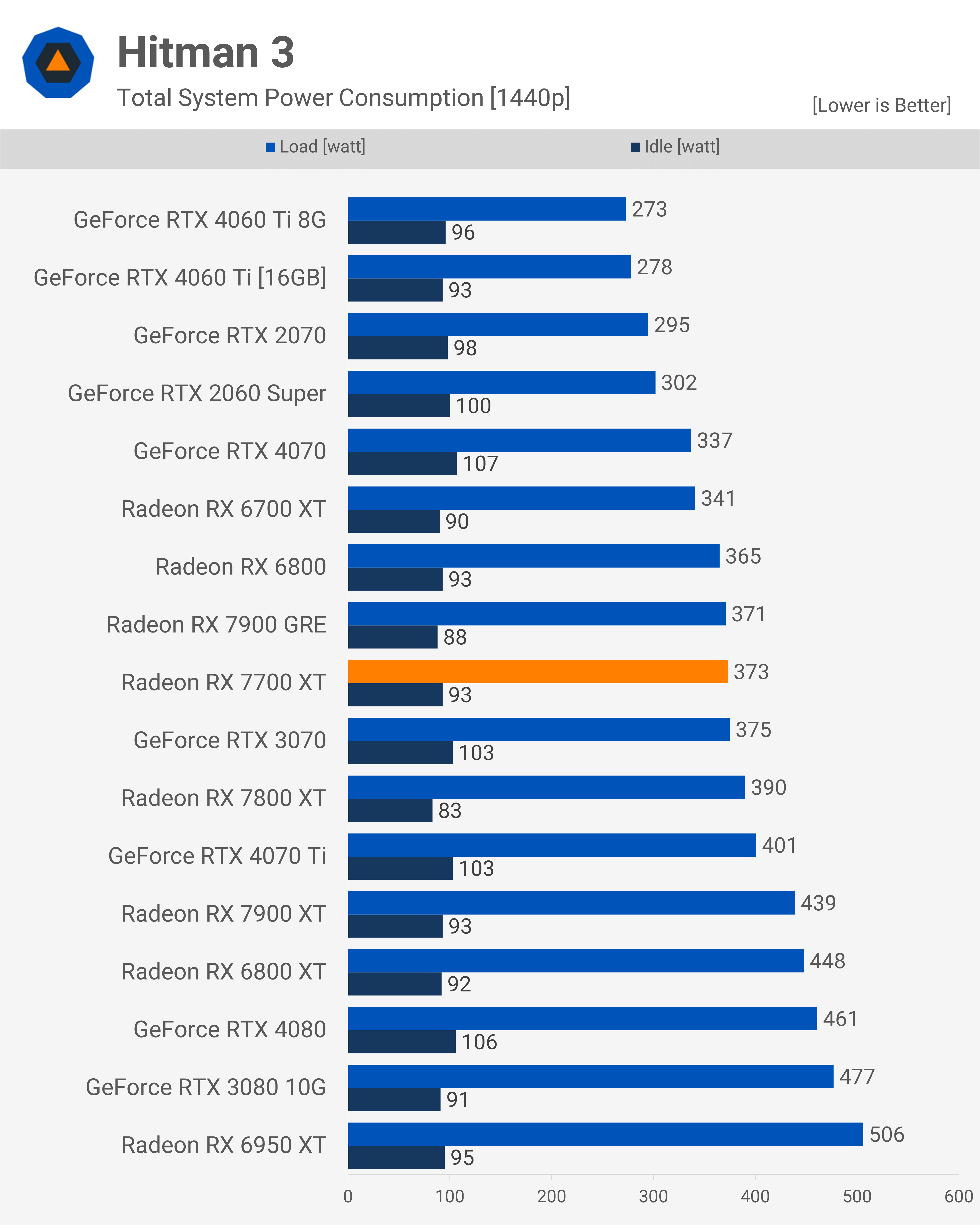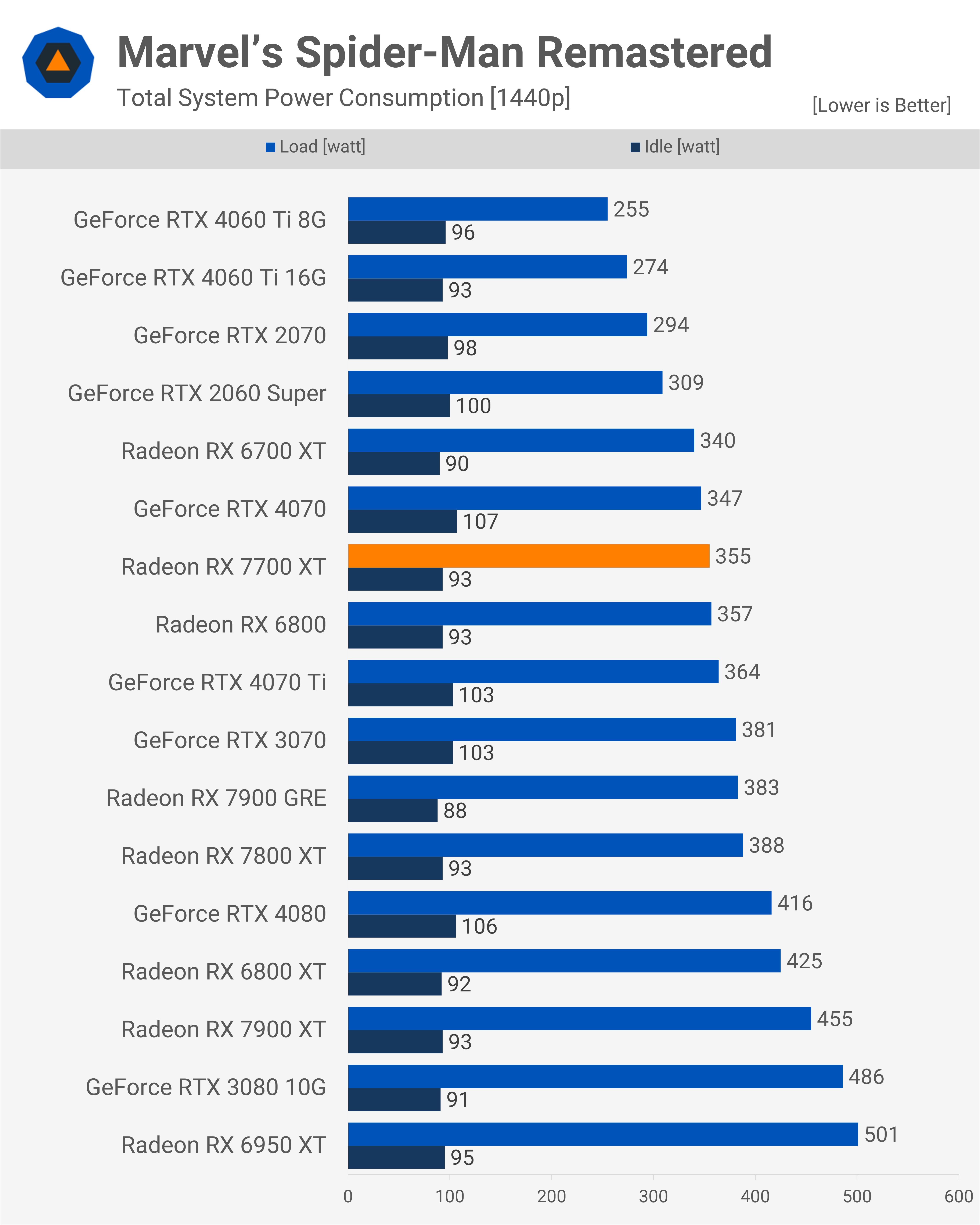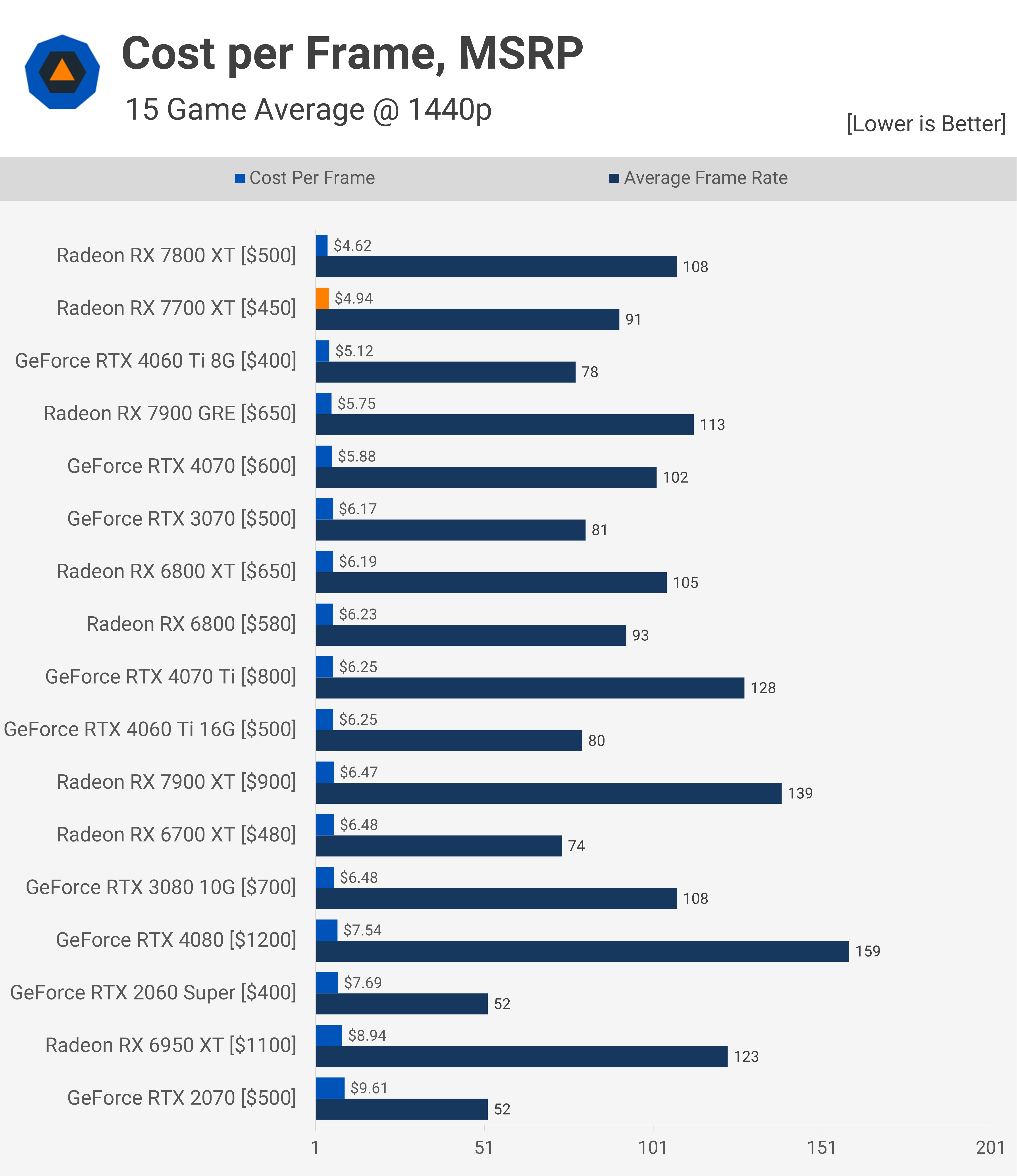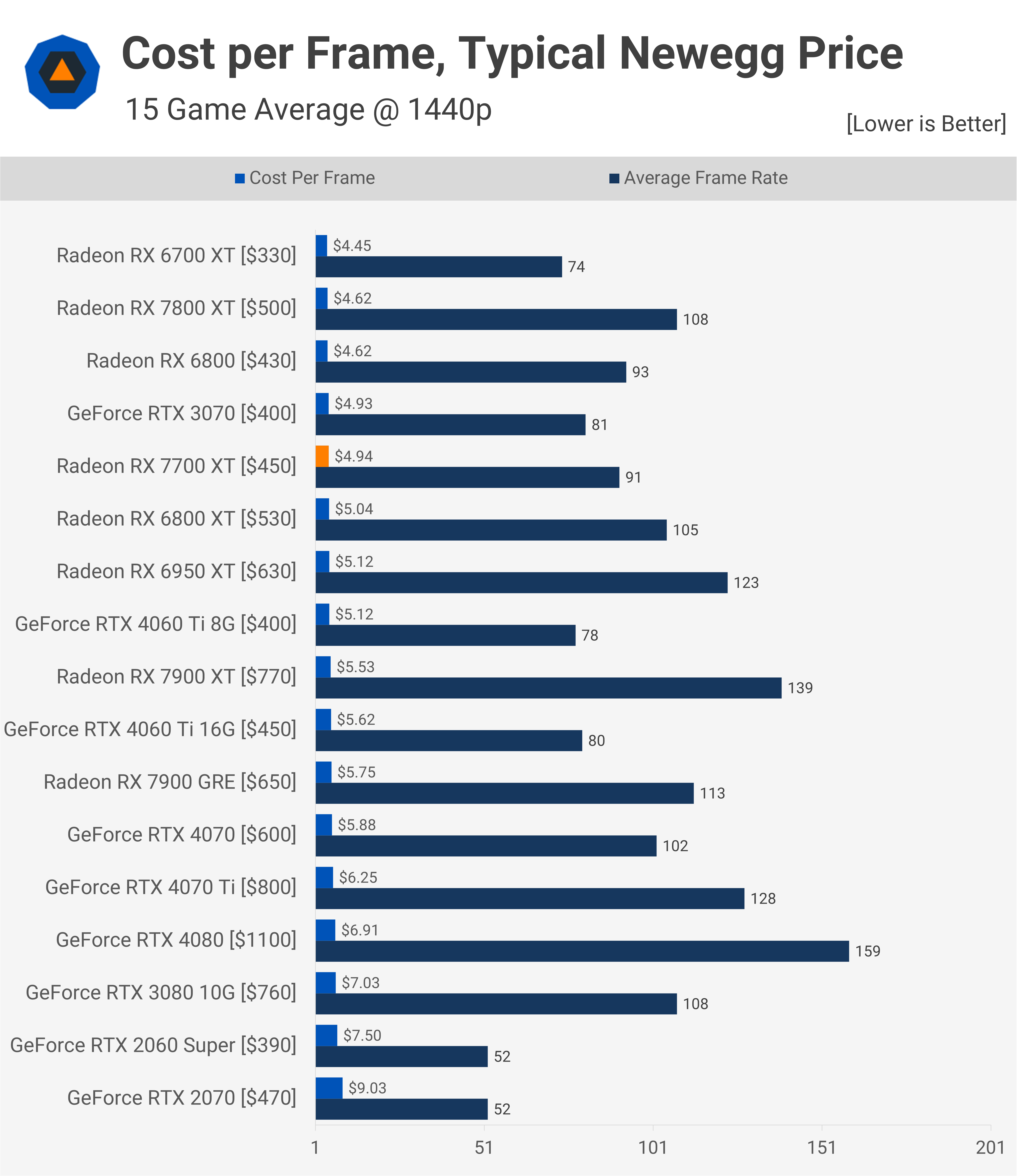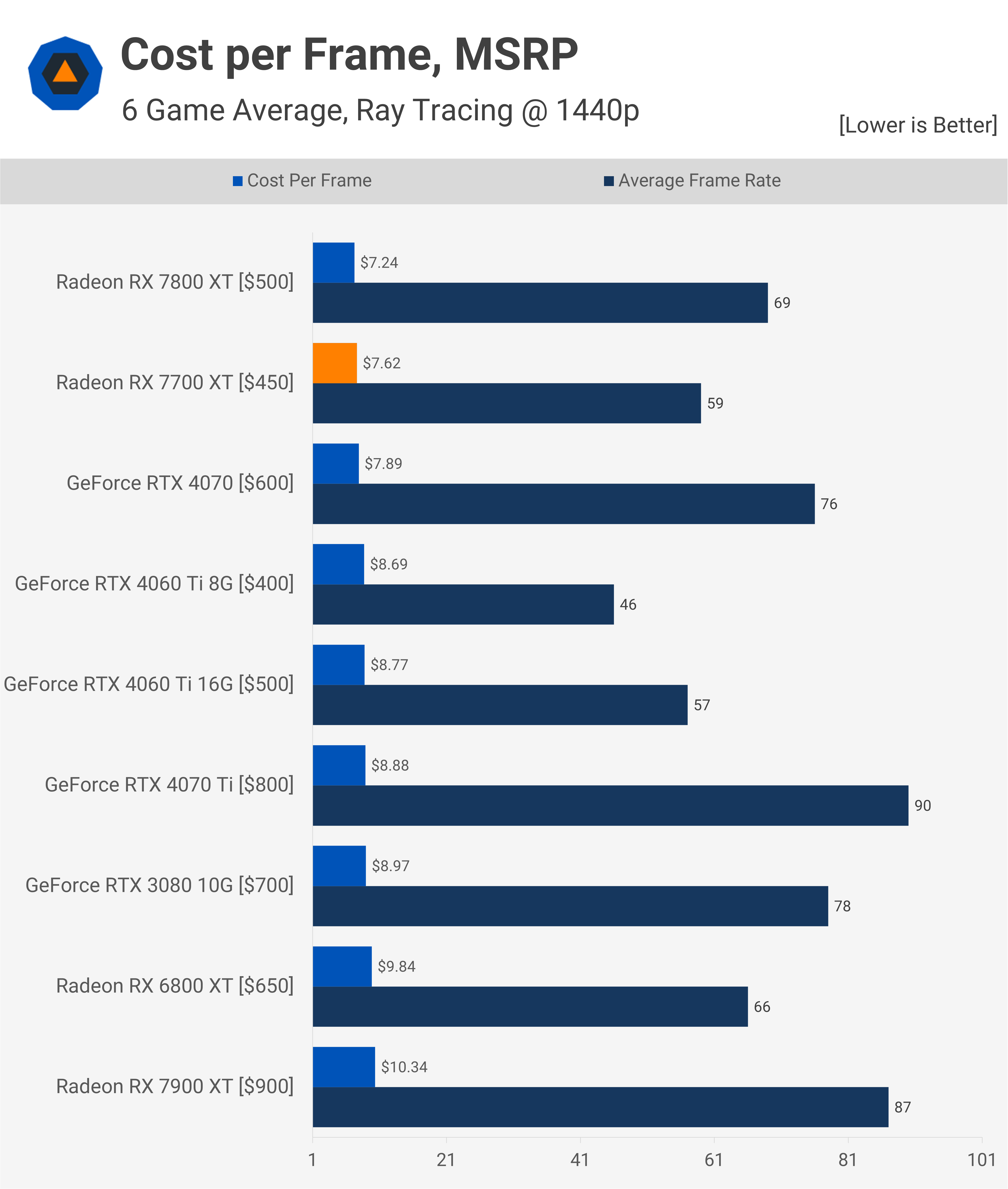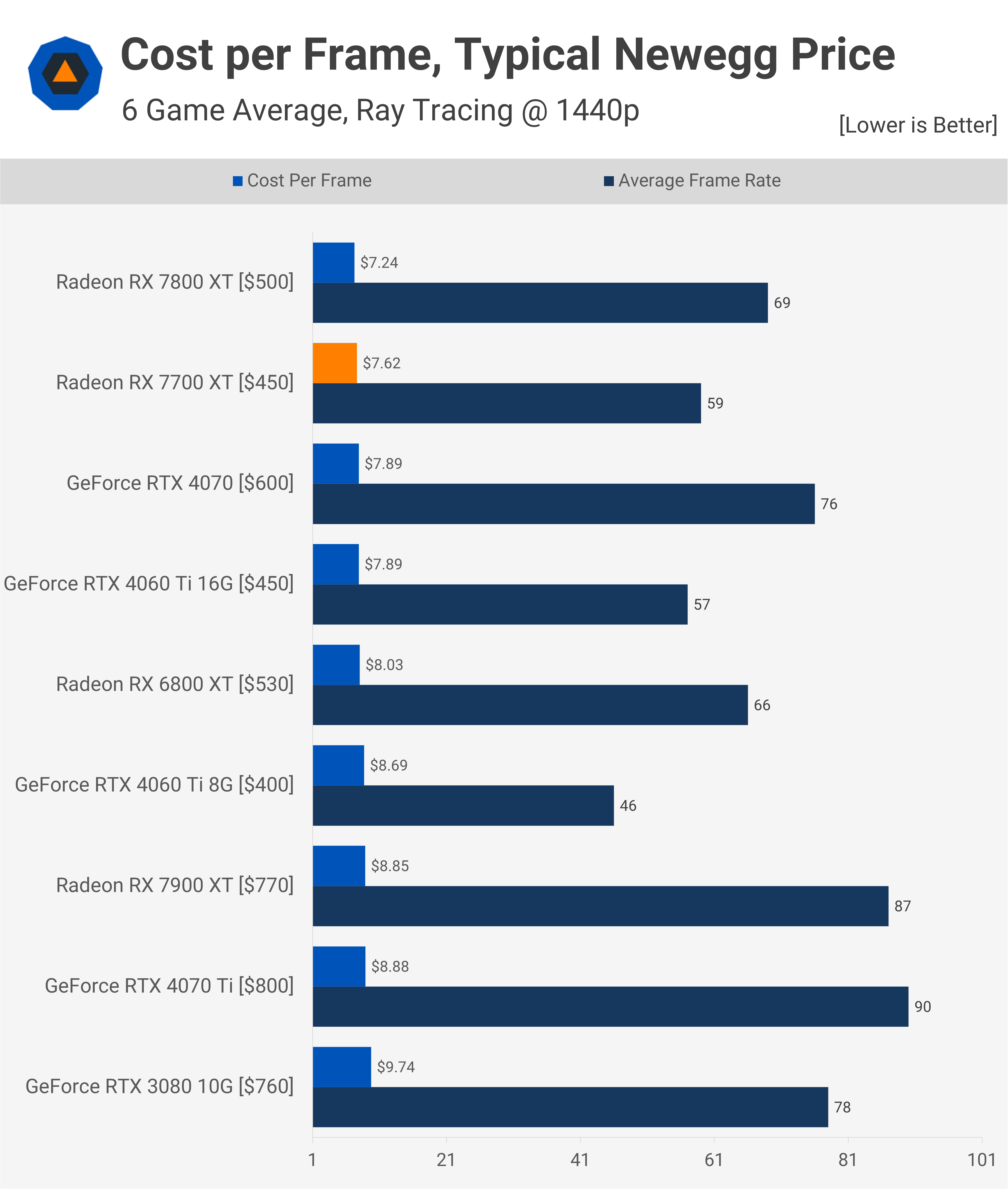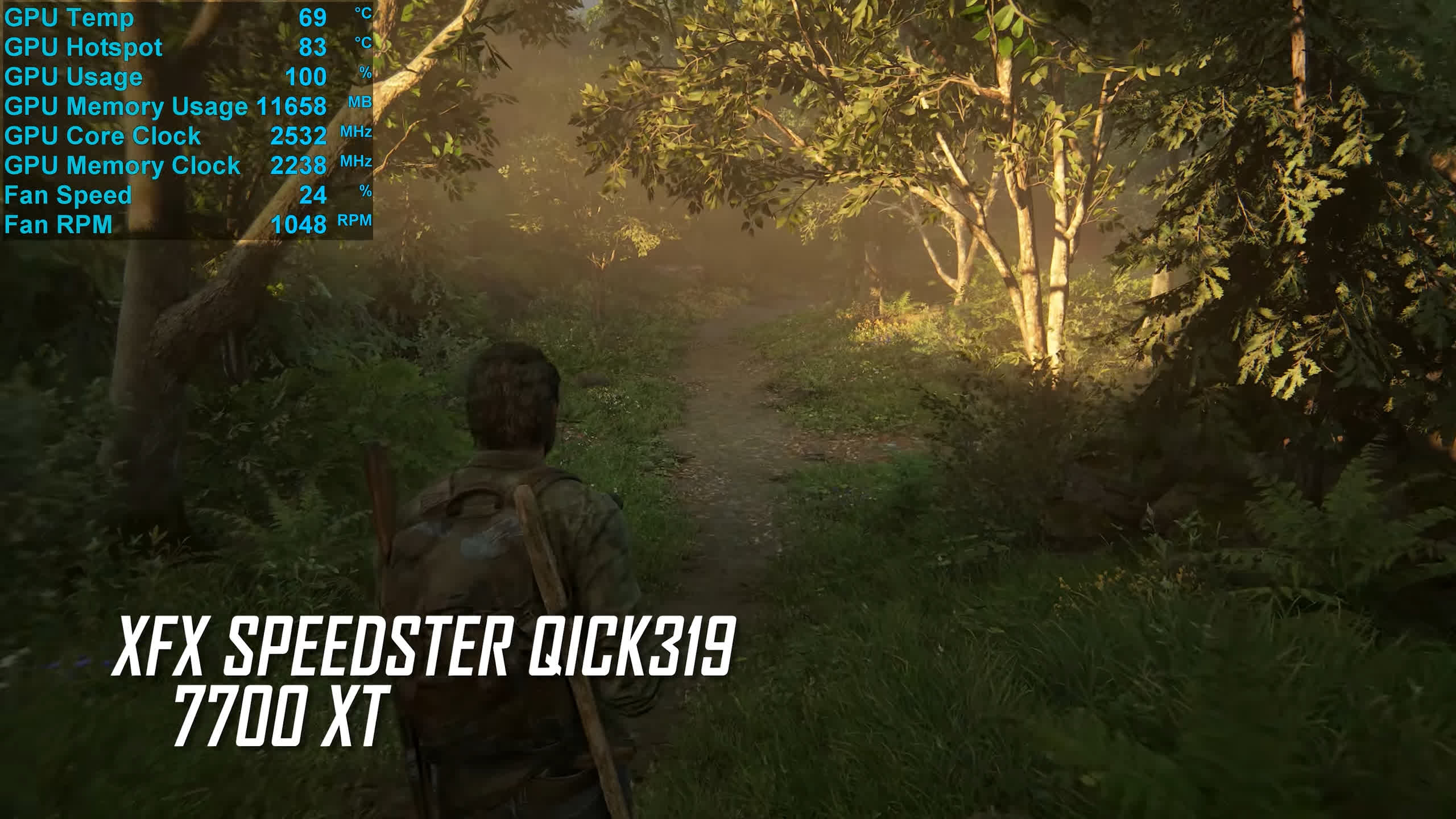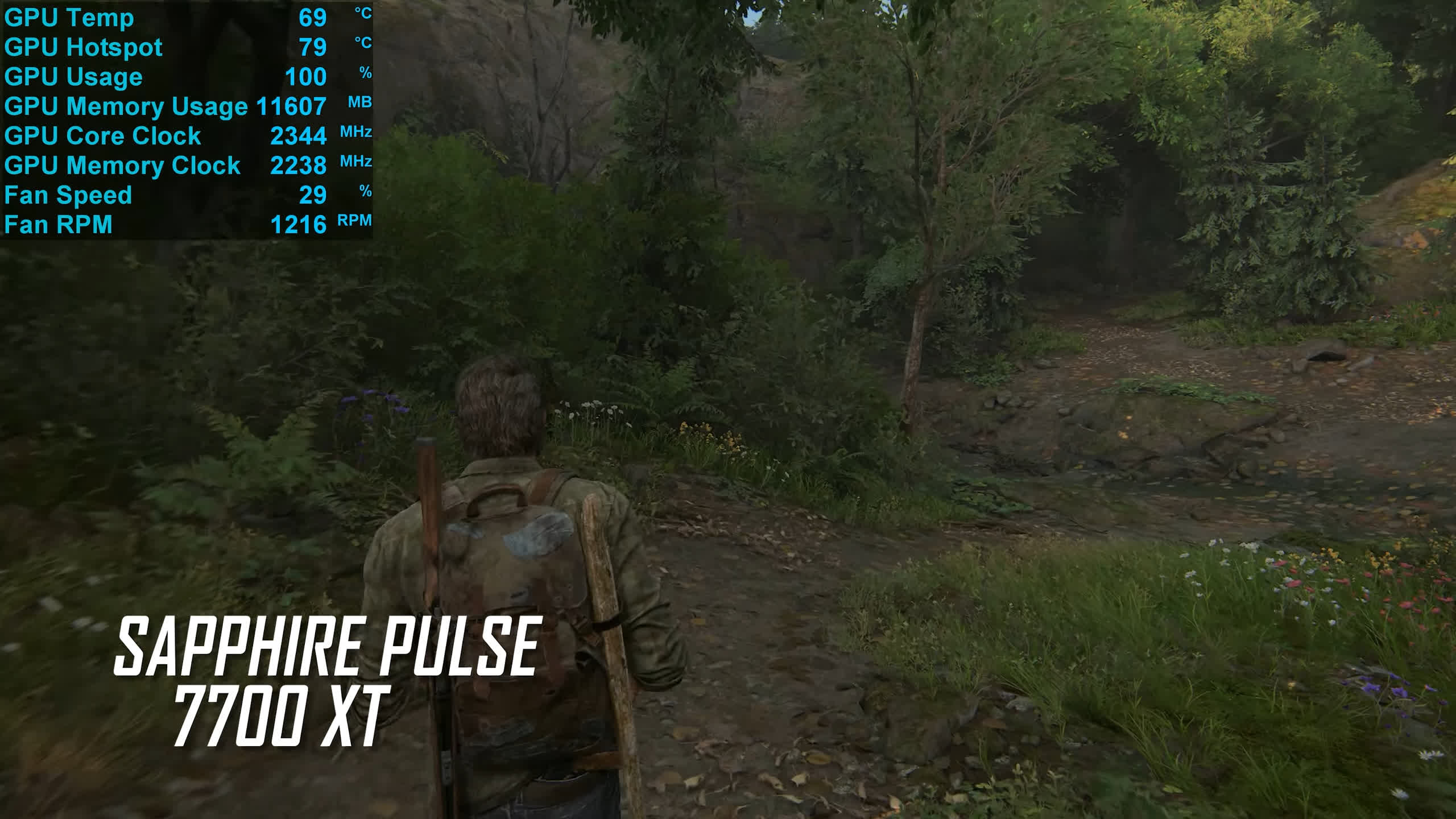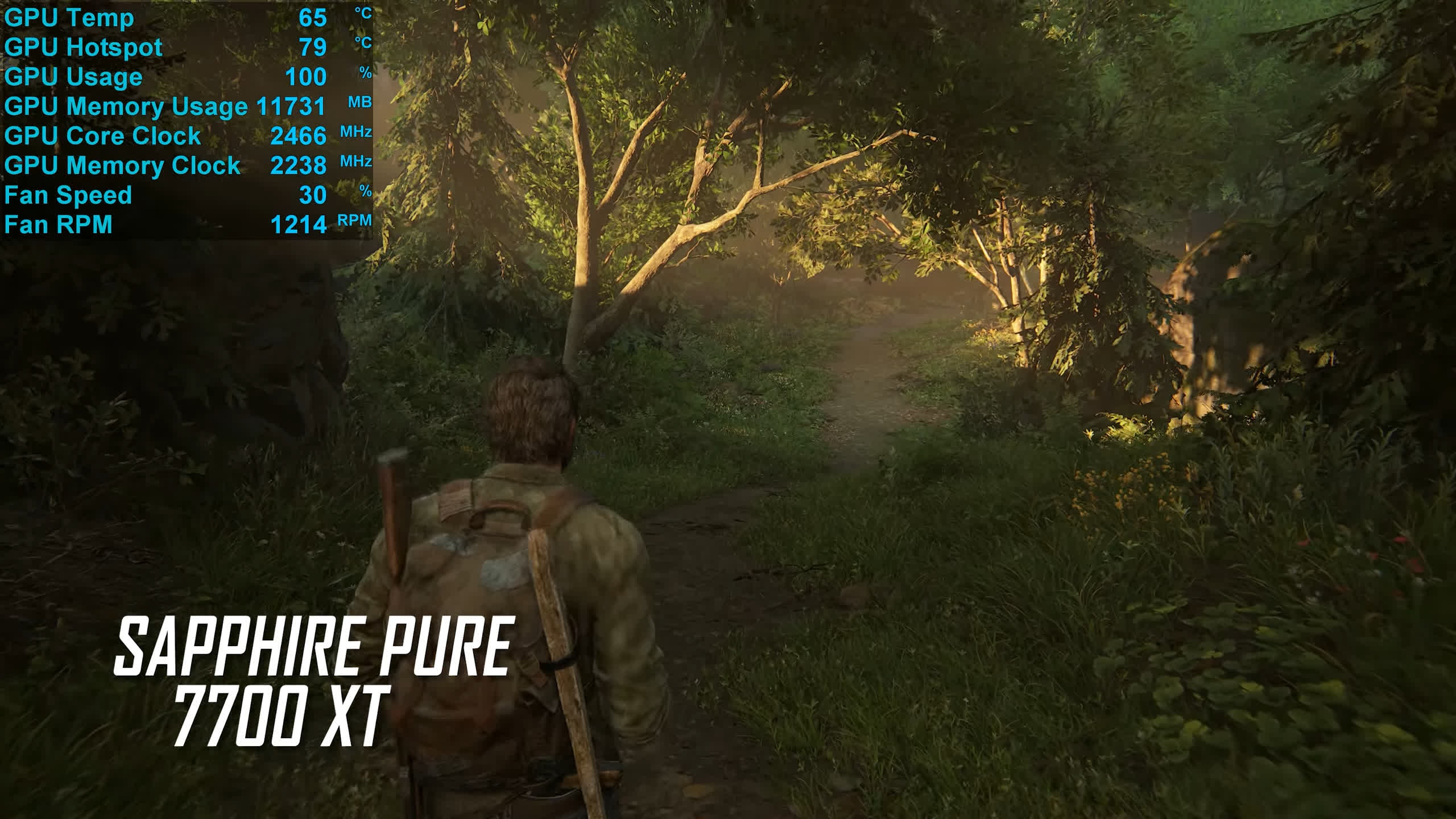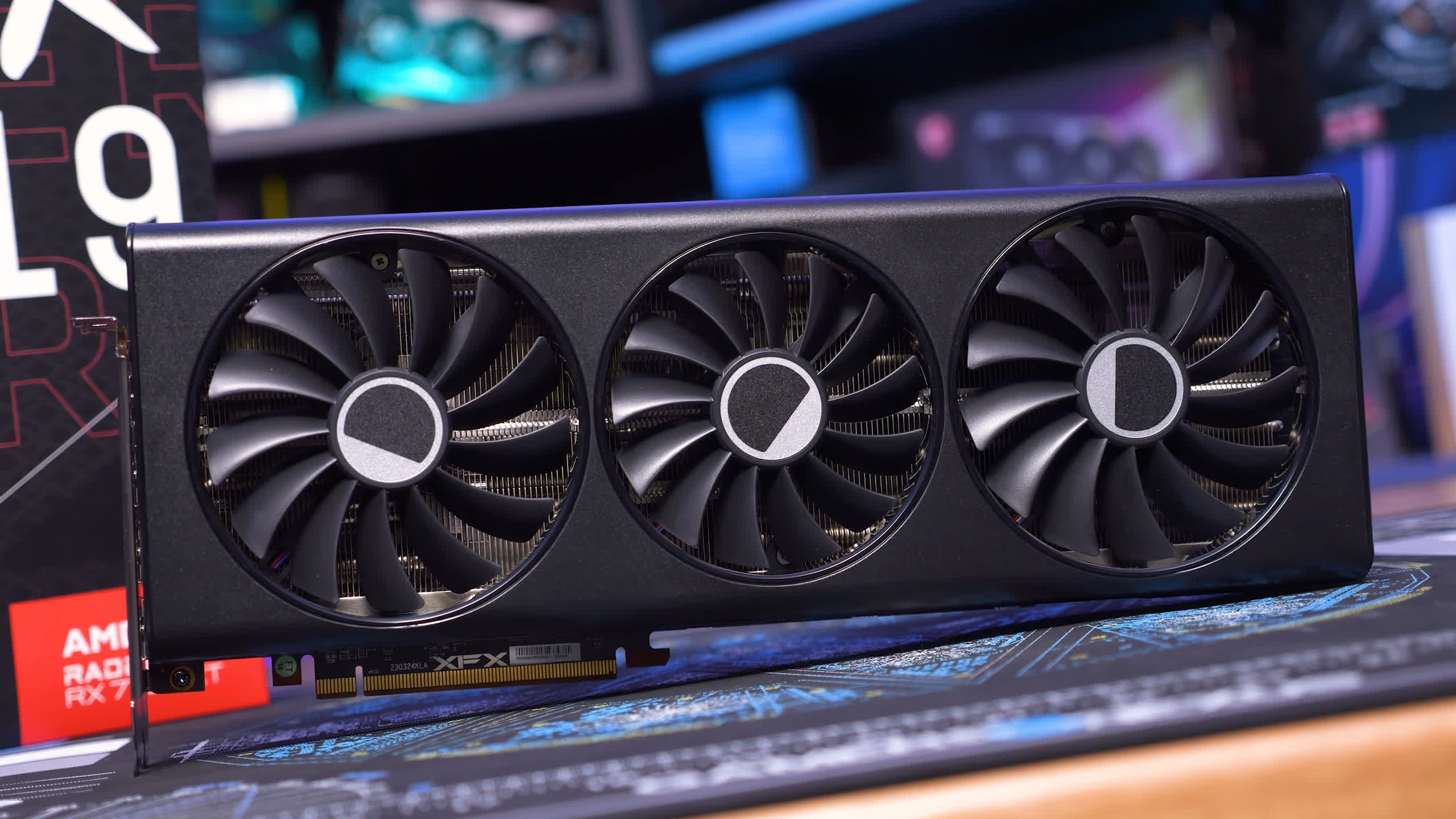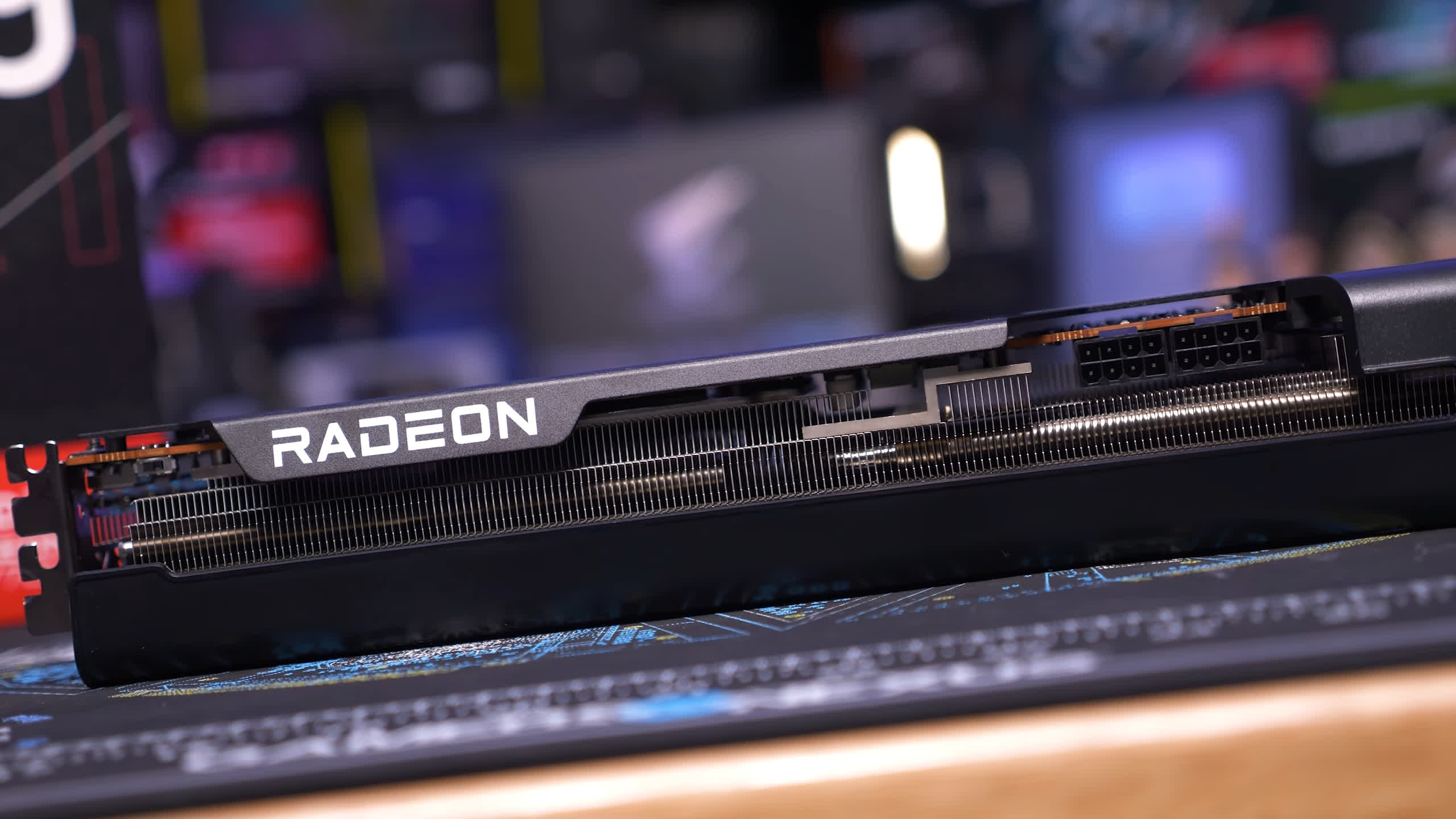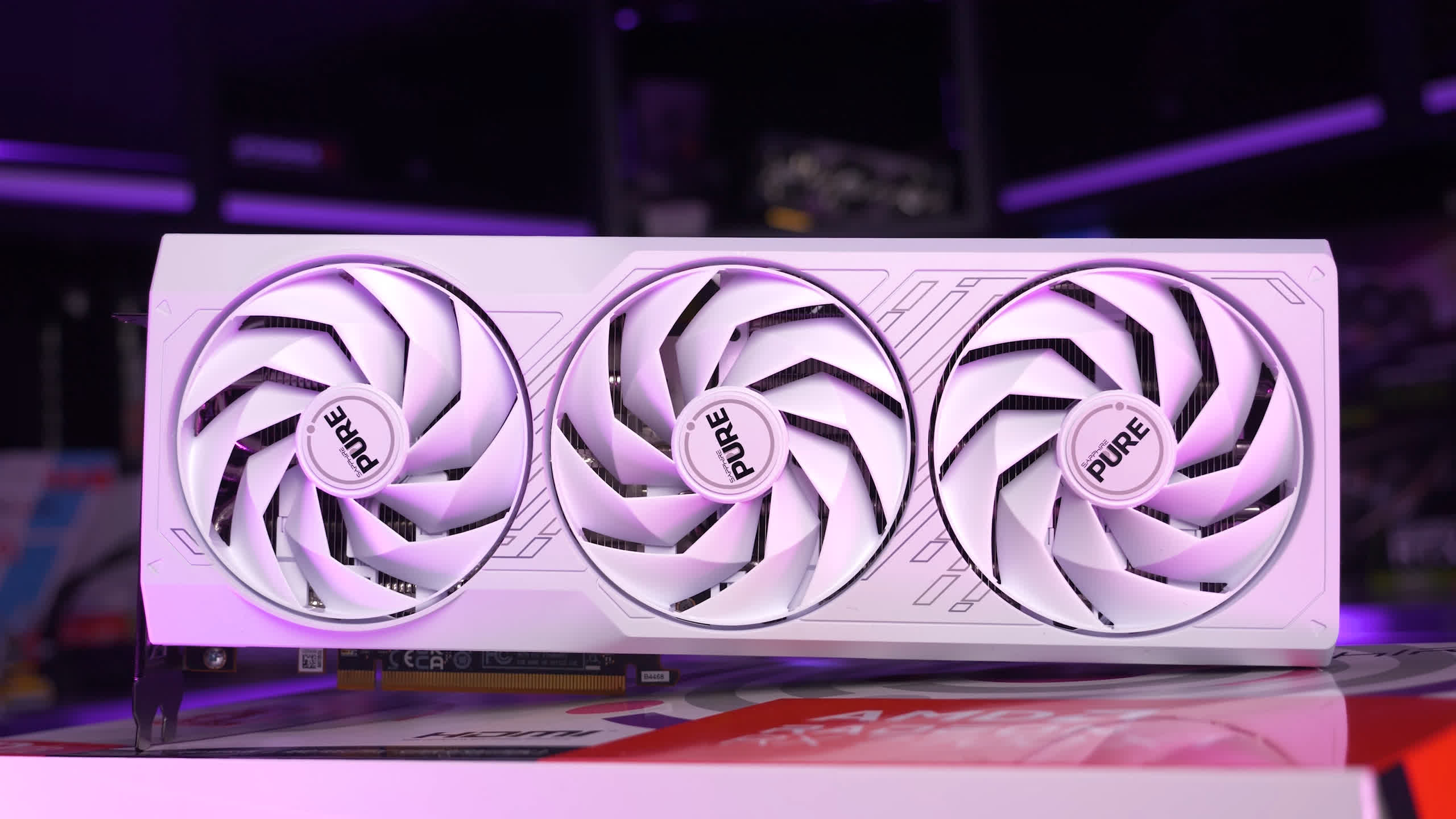The Radeon RX 7700 XT is AMD's latest mid-range GPU targeting the $450 price point. However, even on paper we can anticipate a few issues with the new card. The term "7700 XT" seems ambiguous considering it might even perform slower than the 6700 XT. Moreover, at that price is just 10% cheaper than the Radeon 7800 XT that it launched with in tandem. Given its specifications, this price point might not make much sense.
When compared to the faster 7800 XT, the Radeon 7700 XT boasts 10% fewer cores and a 25% reduction in Infinity Cache, which results in 26% less bandwidth. There's a quarter less VRAM at 12GB, and with a cutdown 192-bit wide memory bus and slower 18 Gbps memory, the memory bandwidth has been slashed by 31% to 432 GB/s.
So it seems as though the Radeon 7700 XT is going to be more than 10% slower than the 7800 XT, making its $450 price tag a tough sell. Not only that, but it seems Nvidia has dropped the 16GB RTX 4060 Ti to $450, so it will be interesting to see how those two compare.
For testing, we used our Ryzen 7 7800X3D test system, equipped with 32GB of DDR5-6000 memory and the most recent display drivers. All data has been validated and updated for this review. In total, we've tested 16 games both with and without ray tracing. As usual, we'll evaluate some individual titles before going through the average performance the cost-per-frame data. Now, let's see what we've got...
Benchmarks
First up is A Plague Tale: Requiem, where the 7700 XT rendered 102 fps at 1080p, which is 11% slower than the 7800 XT but also 11% faster than the 4060 Ti, representing a decent performance uplift at the same $450 price point.
At 1440p, the 7700 XT lags 14% behind the 7800 XT, now only being 9% faster than the 4060 Ti. While this is still a nice uplift, considering the recent drop in the 4060 Ti 16GB's price to $450, AMD might need to step up their game here.
At the 4K resolution, the 7700 XT and 4060 Ti 16GB are neck and neck, leaving no clear winner. Given its 16% performance deficit compared to the 7800 XT, spending an extra $50 seems justified.
In Cyberpunk 2077, the 7700 XT managed an average of 123 fps, standing 13% slower than the 7800 XT. Impressively, it is 16% faster than the 4060 Ti.
Increasing the resolution to 1440p, we see that the 7700 XT is 13% slower than the 7800 XT. However, it performs remarkably well against the GeForce GPU, being 30% faster and substantially outperforming the 4060 Ti in this title.
At 4K, the 7700 XT remains 16% slower than the 7800 XT, but it outpaces the RTX 4060 Ti by a significant 27%, showcasing another solid win for the Radeon GPU against its nearest GeForce competitor.
Moving on to Hogwarts Legacy, the 7700 XT encounters challenges, lagging 20% behind the 7800 XT at 1080p and matching the performance of the older RTX 3070. It is, however, 13% faster than the RTX 4060 Ti.
At 1440p, with an average of 67 fps, it stands 24% slower than the 7800 XT, once again showing RTX 3070-like performance. Despite this, it holds a substantial lead over the 4060 Ti, delivering 18% more frames.
Transitioning to 4K, the 7700 XT's performance drops drastically to 36 fps, on par with the RTX 4060 Ti and 29% slower than the 7800 XT.
In Spider-Man Remastered, we encounter the first instance where the 7700 XT falls behind the 4060 Ti, albeit with much better 1% lows. Its performance at 1080p isn't stellar, lagging 17% behind the 7800 XT and 3% behind the 4060 Ti.
At 1440p, it manages to edge out the 4060 Ti by a few frames but still trails the 7800 XT by an 18% margin. Moving to 4K, the 7700 XT stands 17% slower than the 7800 XT but showcases a 9% improvement over the 4060 Ti, maintaining a playable average of 72 fps.
In The Last of Us: Part I, the 7700 XT is 16% slower than the 7800 XT at 1080p. Interestingly, it mirrors this 16% in its lead over the RTX 4060 Ti.
At 1440p, the gap to the 7800 XT widens, with the 7700 XT trailing by 19%. However, it significantly extends its lead over the RTX 4060 Ti to 27%.
Scaling to 4K creates an unusual scenario where the 7700 XT and 4060 Ti perform equivalently, both substantially lagging behind the 7800 XT.
In our last individual analysis, we examine Fortnite, where none of the RDNA 3 GPUs excel. At 1080p, the 7700 XT is 13% slower than both the 7800 XT and the RTX 4060 Ti.
Yet, as seen frequently, resolution scaling can vary dramatically. At 1440p, the 7700 XT narrows the gap to the RTX 4060 Ti to just 3%. Then, at 4K, it manages to surpass it by 13%, despite still being 15% slower than the 7800 XT.
Performance Summary (Raster)
Across the 15 games tested, the Radeon 7700 XT was on average 14% slower than the 7800 XT at 1080p – a concerning figure considering its 10% lower price. However, it is 9% faster than the RTX 4060 Ti 16GB, which aligns with RX 6800-like performance overall.
At 1440p, the Radeon 7700 XT lags 16% behind the 7800 XT, losing value as the resolution increases. Despite this, it offers better value compared to its closest GeForce competitor, the 16GB RTX 4060 Ti, with a 14% higher average performance.
At 4K, it is 16% slower than the 7800 XT, but outperforms the RTX 4060 Ti 16GB by 18%. While we wouldn't label the 7700 XT a 4K gaming GPU, given its inferiority to the RX 6800 in this regard, its overall performance remains decent.
Ray Tracing Benchmarks
Alright, now it's time to delve into ray tracing performance, starting with Spider-Man Remastered at 1080p. Here, the Radeon 7700 XT aligns with the GeForce 4060 Ti and is just 7% slower than the 7800 XT – a notable result.
However, at 1440p, it lags noticeably behind the 7800 XT, with the gap widening to 16%. Despite this, it still aligns with, or slightly outperforms, the 4060 Ti by a narrow 4%.
At 4K, the 7700 XT is 18% slower than the 7800 XT, showing performance similar to the 4060 Ti. While it's not particularly impressive in comparison to the 7800 XT, it does present good value when considering Nvidia's offerings.
Moving on to Fortnite: at 1080p, the 7700 XT clocked in at 77 fps, marking it as 18% faster than the RTX 4060 Ti – a clear win.
Its performance improved even further at 1440p, stretching its lead to 21%, although it was 15% slower than the 7800 XT.
At 4K, none of these GPUs deliver what we'd deem as "playable" performance, especially without the assistance of upscaling. Nevertheless, the 7700 XT lagged 10% behind the 7800 XT but was 23% faster than the 4060 Ti.
Our last game for individual RT results is Star Wars Jedi: Survivor. At 1080p, the 7700 XT was 7% behind the 7800 XT and 7% ahead of the RTX 4060 Ti.
At 1440p, it fell short of the 7800 XT by 15% and narrowly surpassed the RTX 4060 Ti.
In the 4K domain, the 7700 XT lagged 22% behind the 7800 XT, achieving only 25 fps, on par with the RTX 4060 Ti.
Ray Tracing Performance Summary
Across all six tested games with ray tracing enabled, the 7700 XT averaged 12% slower than the 7800 XT, while it was on par with the 4060 Ti. This suggests that Nvidia's RT advantage may be diminished in this particular matchup.
At 1440p, the 7700 XT was, on average, 14% slower than the 7800 XT but edged out the 4060 Ti with more consistent 1% lows.
Though the 4K data isn't as crucial given the resulting performance, the 7700 XT was 18% slower than the 7800 XT and 7% faster than the RTX 4060 Ti.
Power Consumption
One significant drawback of the Radeon 7700 XT, especially when compared with its main rival, the RTX 4060 Ti, is power efficiency. Measurements from Hitman 3 indicate that the 7700 XT boosted system usage by a significant 34%. This isn't ideal, considering the performance was largely comparable.
A similar pattern emerges in Spider-Man. Here system consumption surged by 30% with the 7700 XT, yet the fps performance remained relatively unchanged. AMD seems to be trailing in power efficiency, which is not ideal. However, at least in this instance, the total power consumption isn't alarmingly high.
Cost Per Frame
This comparison highlights the problem with the Radeon 7700 XT. Certainly, when set against the 4060 Ti – even the 8GB variant – the 7700 XT appears slightly better in terms of value. However, priced just $50 below the 7800 XT, its value proposition diminishes. This analysis doesn't even account for the fact that it has 4GB less VRAM. It's hard to justify saving $50 to opt for the 7700 XT.
When we incorporate current retail pricing into the mix, the decision becomes even clearer. The Radeon 6700 XT, boasting 12GB of VRAM, offers much better value at present. There's also the RX 6800, which is a tad cheaper and slightly faster, and it comes with an even larger VRAM buffer of 16GB.
Analyzing cost-per-frame based on ray tracing data, we once again find the 7800 XT offering superior value, rendering the 7700 XT somewhat redundant.
And when one factors in the current retail prices of prior generation products, the picture becomes increasingly bleak for the 7700 XT.
Cooling Performance
As we approach the conclusion of this review, let's examine the operational behavior of the XFX Speedster Quik 319 model. After an hour of in-game stress, it registered a junction temperature of 70°C with a peak hotspot of 85°C – pretty good results there, particularly given the fans were operating at a mere 1000 RPM. As for the cores, they consistently clocked at 2530 MHz during tests in The Last of Us Part 1 at 4K.
We also tested the Sapphire Pulse, which reached a maximum junction temperature of 70°C and a hotspot of 80°C. These are the same temperature readings as the XFX model, although its fans spun slightly faster at 1200 RPM and were faintly audible over our case fans. Its cores clocked considerably lower, at 2340 MHz, marking an 8% decrease.
Lastly, we had the Sapphire Pure for testing. It achieved a peak junction temperature of just 66°C, though its hotspot still touched 80°C. The fan speed remained at 1200 RPM, but this time the cores maintained an average clock frequency of 2450 MHz, which is just 3% below the frequency of the XFX model.
What We Learned
AMD's Radeon RX 7700 XT strikingly echoes the 7900 XT release in its pricing strategy – it is positioned alarmingly close to the next-tier product – the 7900 XT was only 10% less expensive than the 7900 XTX, yet it lagged by an average of 17% in 4K performance and came with less VRAM. AMD eventually rectified this by reducing the price by roughly $100, making the 7900 XT about 20% more affordable.
This is precisely the move they need to make with the 7700 XT. We anticipate this part will soon be priced around $400, putting it at 20% less than the 7800 XT, and crucially, making it worth purchasing at that price point. That would also price it to match the 8GB RTX 4060 Ti, a product the 7700 XT would demolish.
It's a bit frustrating that AMD finally managed to release a product at the right price with the 7800 XT, only to screw over the 7700 XT by pricing it at least $50 higher than it should be. It's almost irrelevant how the 7700 XT stacks up against Nvidia counterparts when positioning next to a similarly priced Radeon GPU is nonsensical.
To put it bluntly, purchasing the Radeon 7700 XT at $450 is ill-advised when the 7800 XT is available, leaving us questioning AMD's rationale behind this launch. If the 7700 XT does drop to $400 in the coming weeks, AMD needs to look at changing the way they approach Radeon products.
Repeating such a pricing blunder would be a disservice to the Radeon division. Or maybe we're not understanding the incredible strategy at play here that sees AMD release a product at an obviously unsuitable price, resulting in mediocre reviews, followed by poor sales, only to cut pricing to an acceptable level weeks or months later...
We hoped that after the Radeon 7900 XT's lessons, such tactics were history – especially when the 7800 XT launched at a sensible $500. But setting the 7700 XT at $450? It's puzzling, to say the least. To conclude, don't buy this thing at $450. However, at $400, it could very well be an option worth considering.
